Last updated: 24th February 2024
Delhi was the first stop on our small group tour of exotic India. Most visitors only use the airport as a stepping stone for the classic ‘Golden Triangle’ route (Delhi, Agra and Jaipur). However we wanted to see what Delhi had to offer. In this guide we’ll show you the top sightseeing spots and all the delicious street food with tips on how to avoid Delhi belly!
Table of Contents
Delhi – India’s Chaotic Capital City
Delhi is rich in culture and definitely worth exploring for a couple of days, although we ended up with more like a day and a half because our connecting flight in Dubai was delayed for over 8 hours! Delhi is like most capital cities – super busy and over crowded. 30 million people live here – that’s more than the entire population of Australia it’s the 2nd most populated city in the world. Delhi is loud with the tooting of horns in endless traffic jams and the pollution is just as bad as what we experienced in Beijing, China. Smog always lies over the city so take a face mask, especially if you are an asthma sufferer.
A Brief History of Old Delhi and New Delhi
Delhi is split up into 2 contrasting areas – Old and New Delhi. The city’s official name is ‘New Delhi’ however most people just call it ‘Delhi’. As India’s capital city it’s one of the oldest cities in the world. Delhi has a diverse history and retains many architectural wonders – a legacy of the Islamic Mughal Empire that ruled most of Northern India between 1526-1857.
Old Delhi is where you’ll find the big architectural sights. It used to be a walled city with 15 gates, 5 of them remain today. It was founded by the Mughal Emperor Shah Jahan. In 1639 he moved India’s capital from Agra to Delhi and called it ‘Shahjahanabad’. By 1803 the British had taken over rule of Delhi and began rebuilding the city on a grand scale. New Delhi was built with new neighbourhoods, tree lined boulevards and elegant buildings designed by British Architects Sir Edwin Lutyens and Sir Herbert Baker. In 1911 the British Raj moved its power base from Kolkata to New Delhi and to this day, the city remains the capital of India. Old and New Delhi are really two cities of complete contrast that sit side by side.
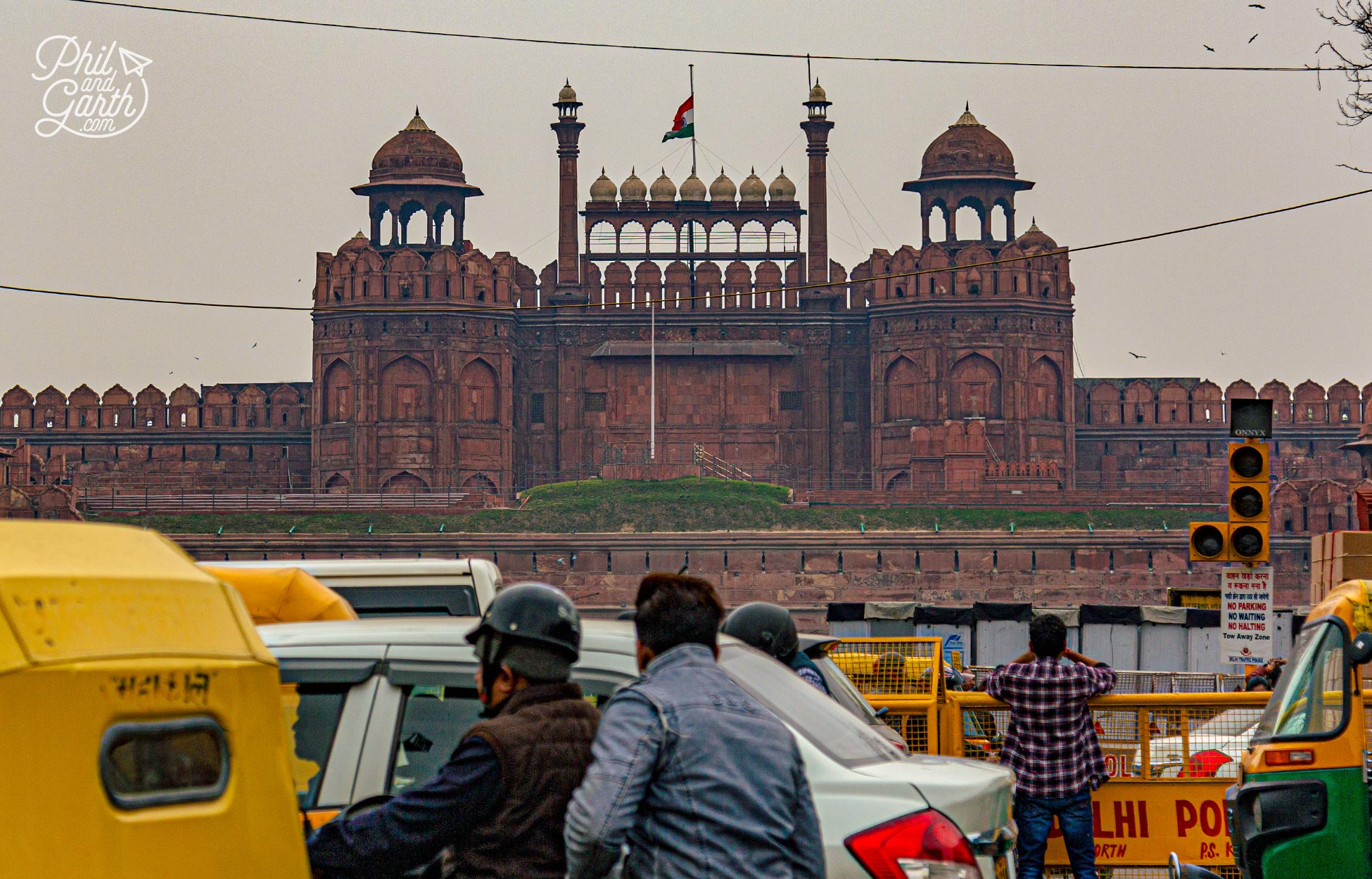
The historic Red Fort at the heart of Old Delhi
Top Places To Visit In Delhi
Humayun’s Tomb in New Delhi
On our first day we took an Uber from our hotel to Humayun’s Tomb located in New Delhi. Getting there was interesting travelling down the wide boulevards of New Delhi, on first sight it reminded us a bit of Phnom Penh in Cambodia. It was also quite sad witnessing the desperate poverty amongst all the grandeur. Lots of families live with nothing on the pavements or under bridges right next to the roads.
When you get to Humayun’s Tomb join the ‘foreigners’ queue to skip the long regular one. It costs 600 INR (£6.10) for tourists and 30 INR for locals. Humayun’s Tomb is a UNESCO World Heritage Site and is a grand mausoleum containing the grave of Emperor Humayun. He was a Mughal Emperor that used to rule over Delhi. The tomb was commissioned by his first wife 9 years after his death. Other members of the Royal family are also buried on this site.
Completed in 1570 this was the first grand garden-tomb to be built in India. Crafted in red sandstone and white marble it’s an incredible sight. The architecture uses perfect symmetry and combines Persian and Mughal craftsmanship. We thought it looked like a red version of the Taj Mahal. It’s actually no coincidence because Humayun’s Tomb was the inspiration behind the design of the Taj Mahal.
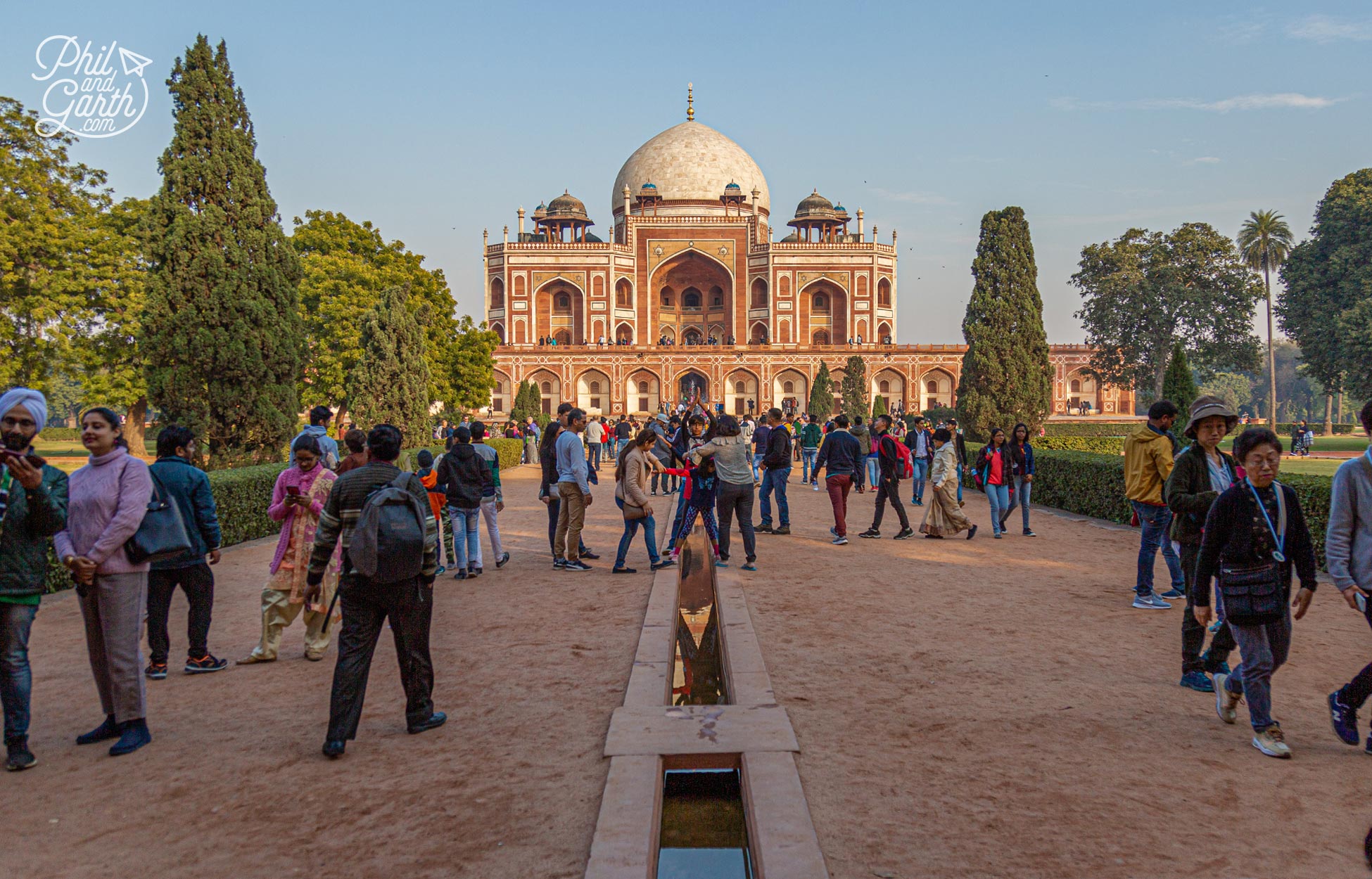
The classic view of Humayun’s Tomb as seen from the entrance
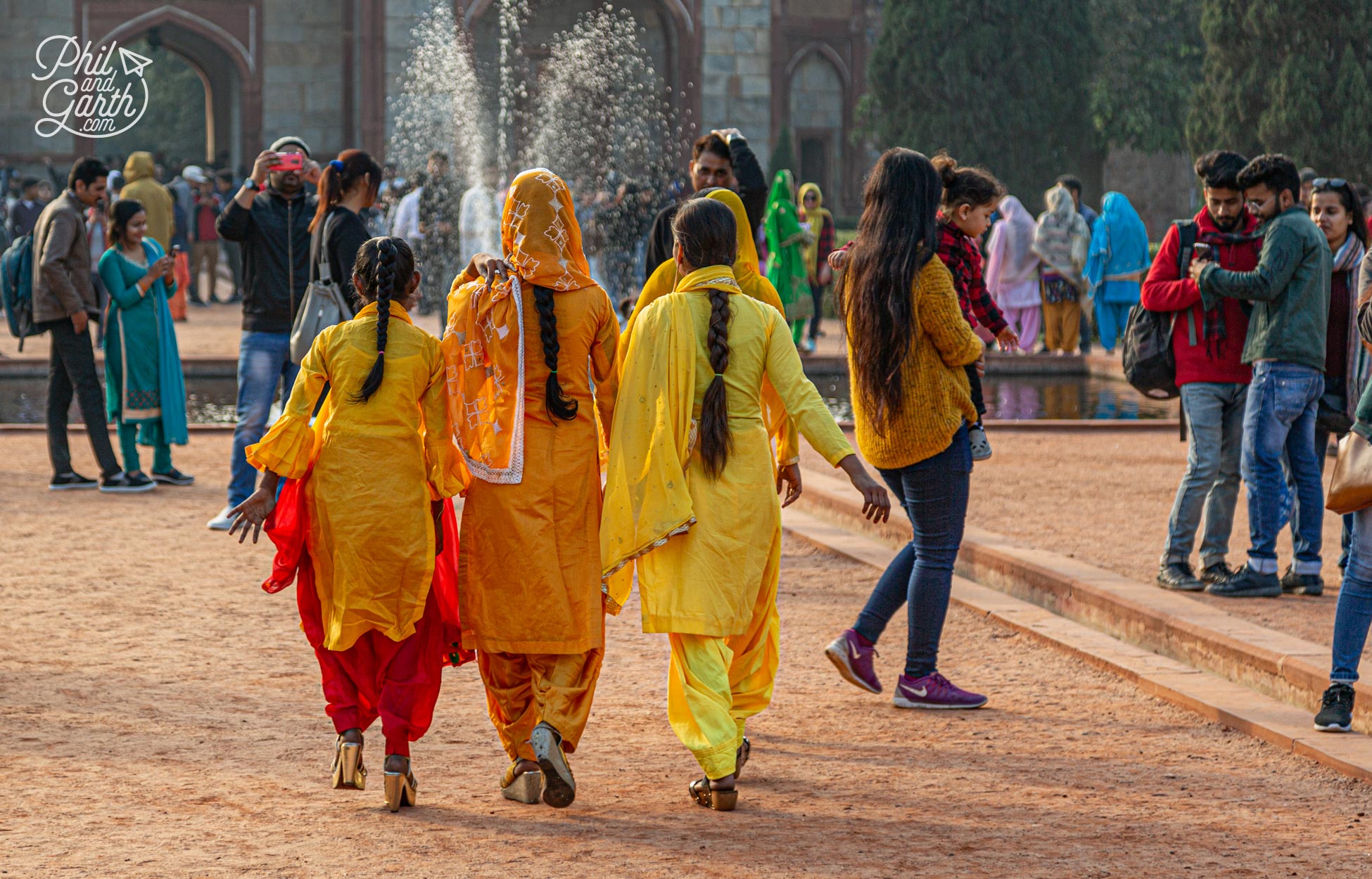
Lots of local families here and not many western tourists
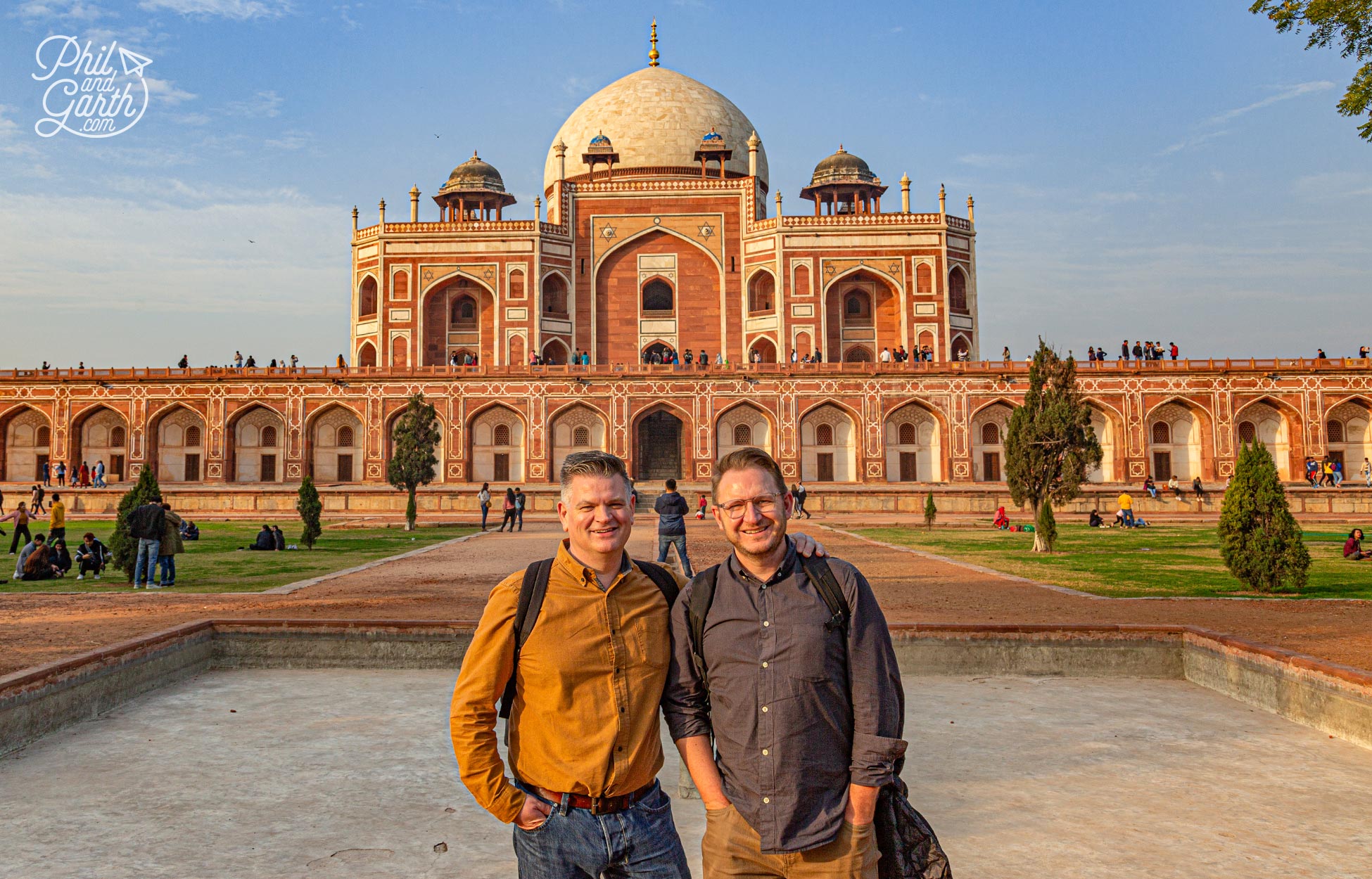
Humayun’s Tomb was the inspiration behind the design of the Taj Mahal in Agra
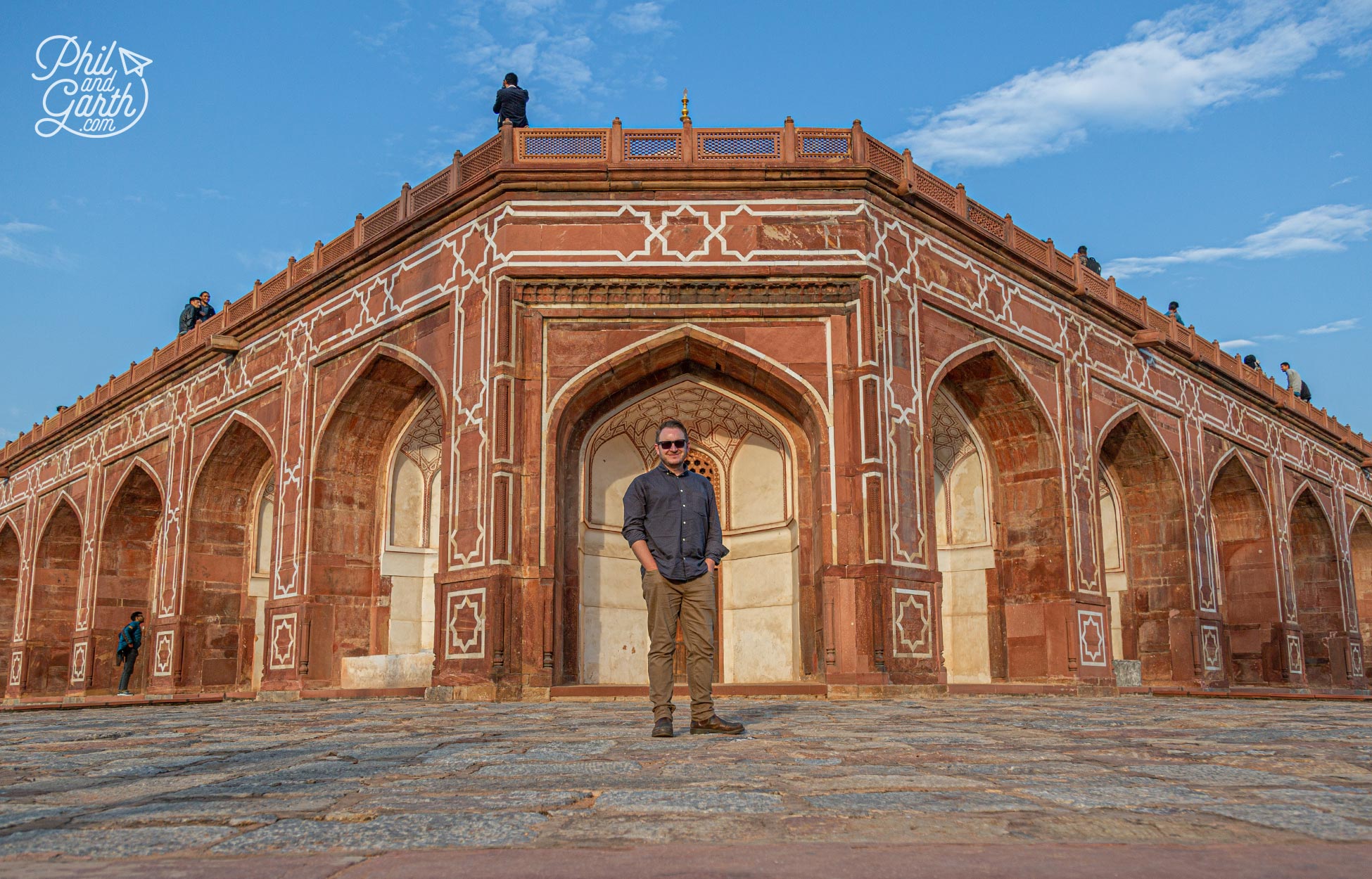
Garth on one of the terraces at Humayun’s Tomb
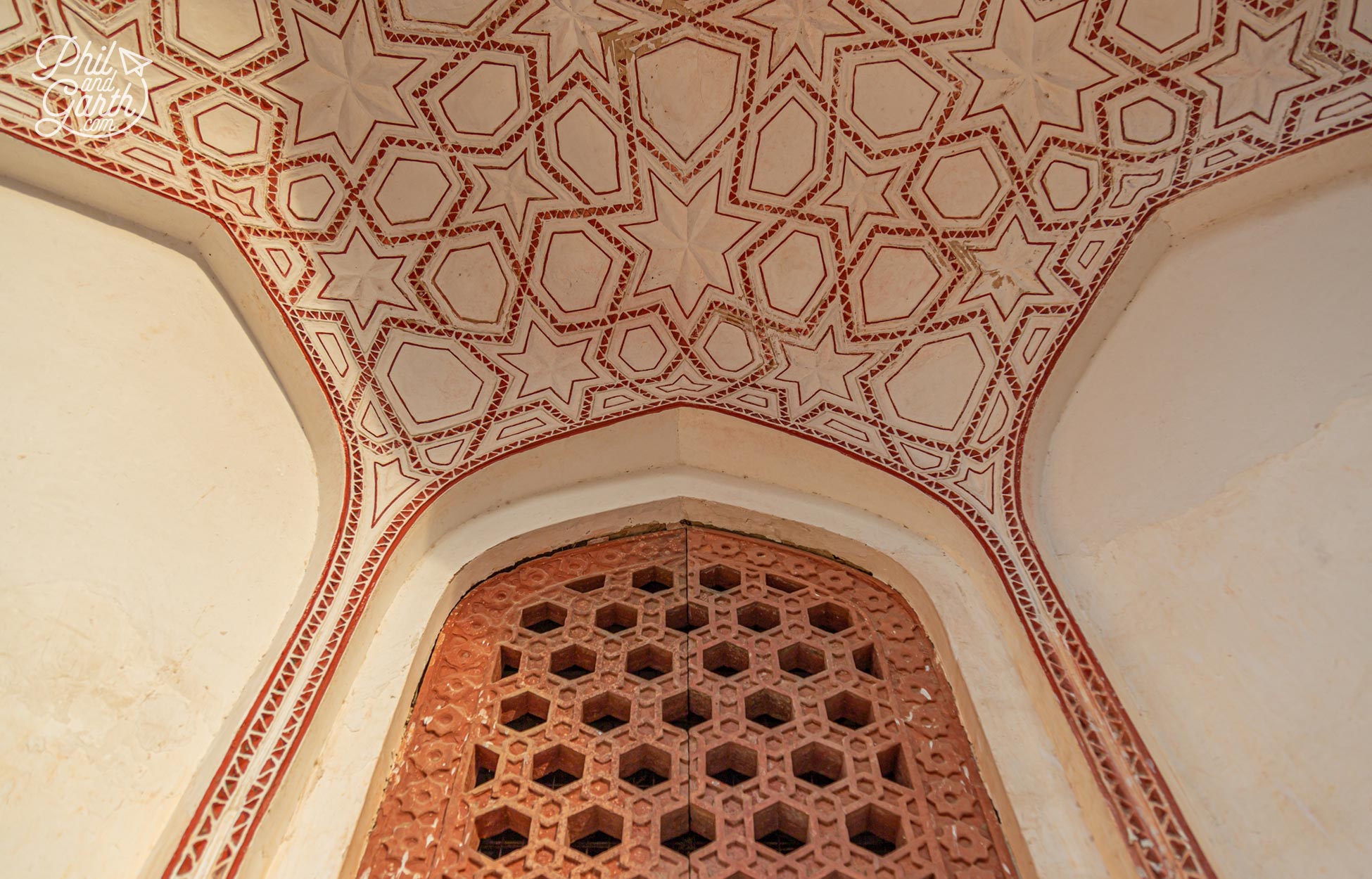
After 200 years of neglect it has been beautifully restored
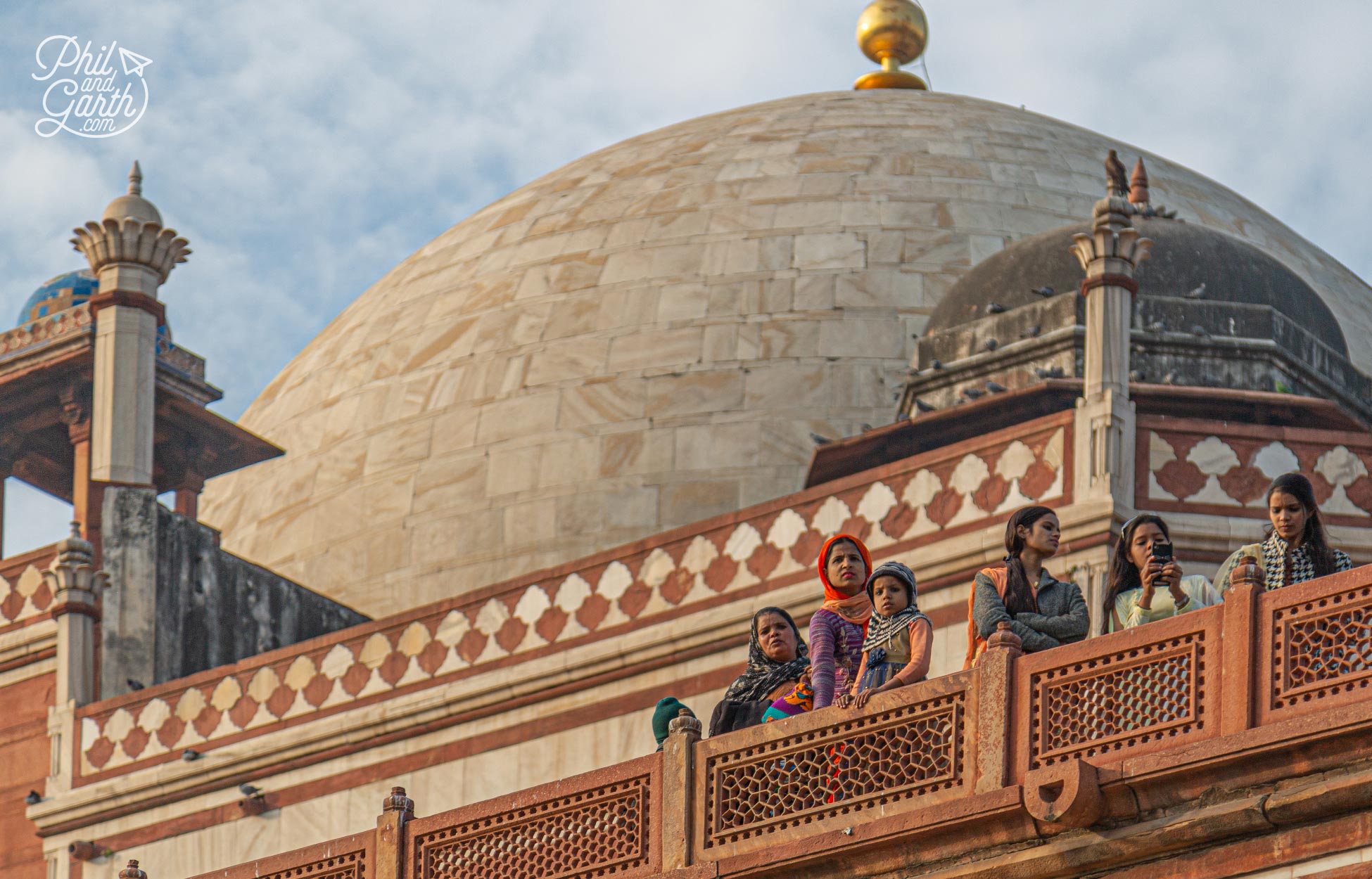
The central dome is double layered. The exterior is covered in white marble
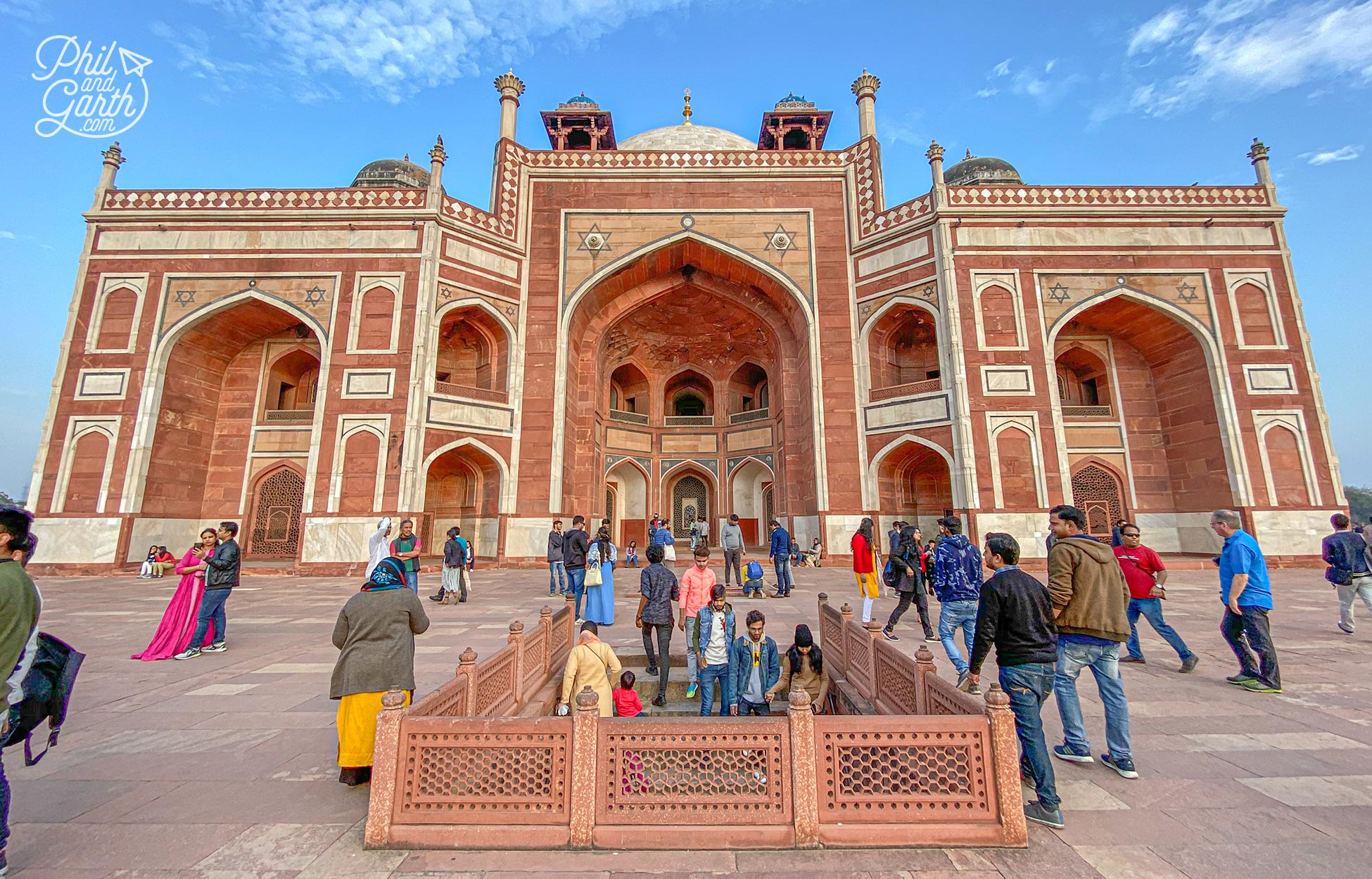
View from the upper platform where you’ll find the entrance to the inside hall
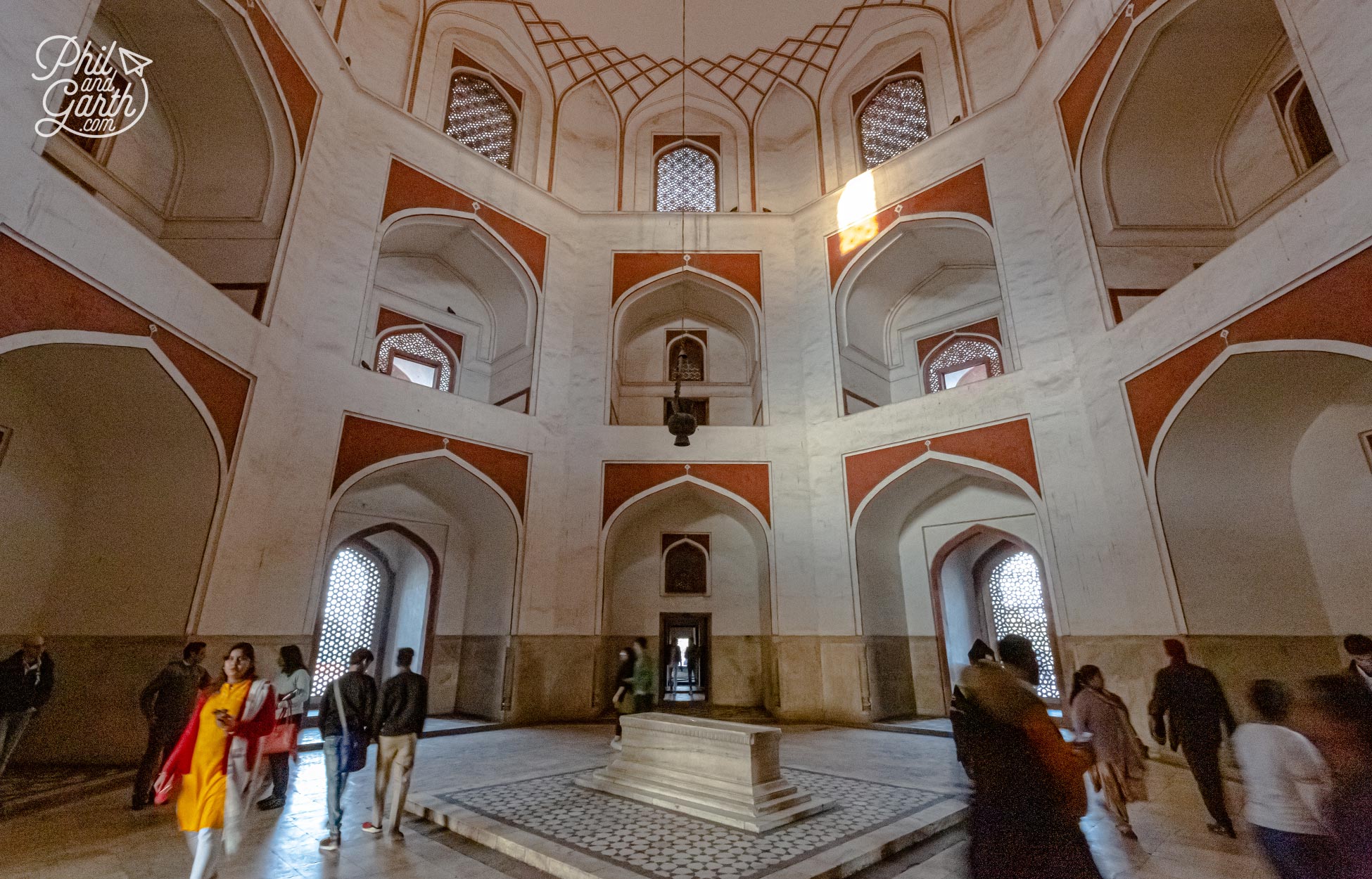
The inside hall of Humayun’s Tomb. The tomb’s head faces west to the holy Mecca
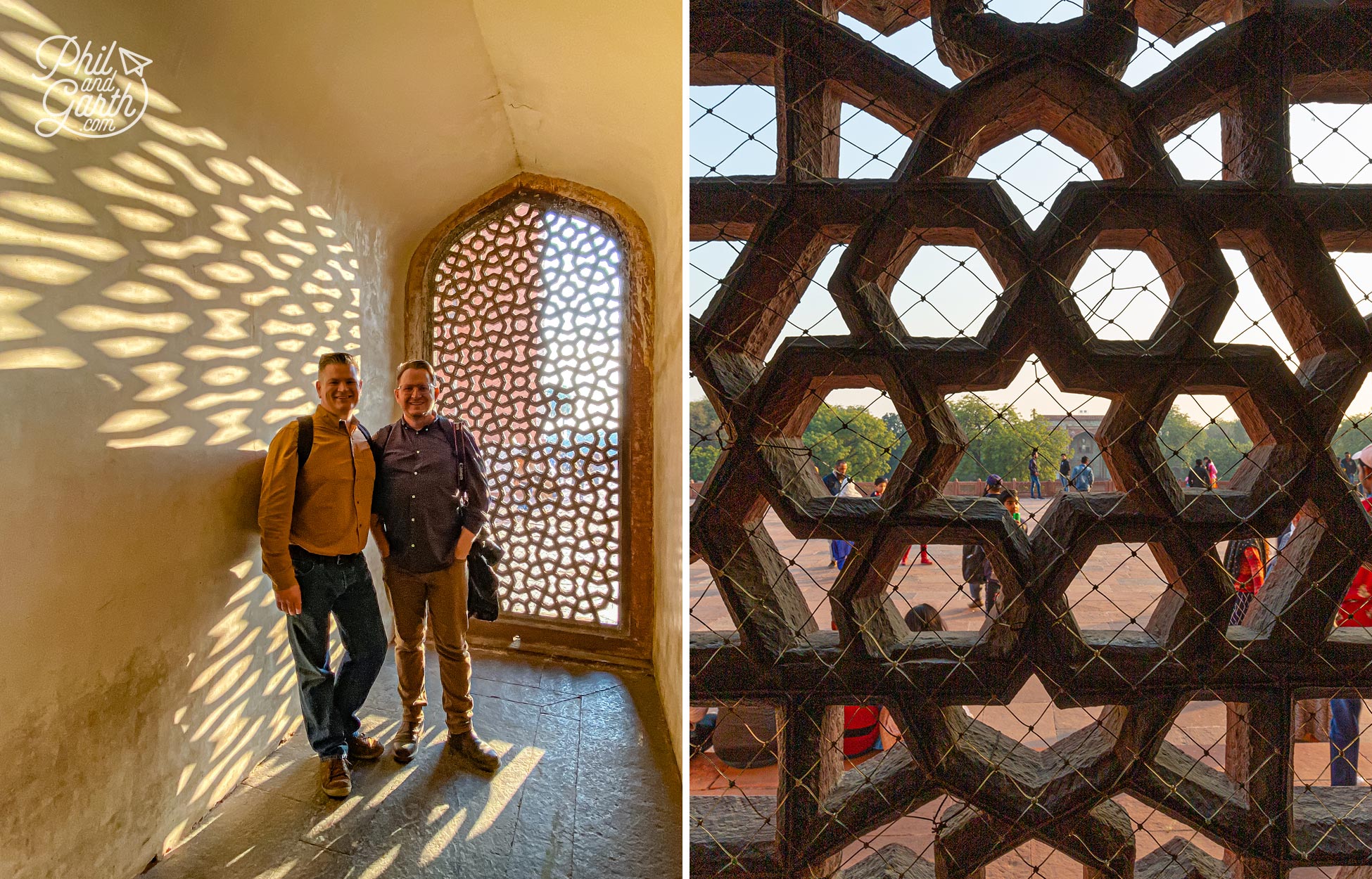
Fabulous low light shadows cast by a lattice stone window inside
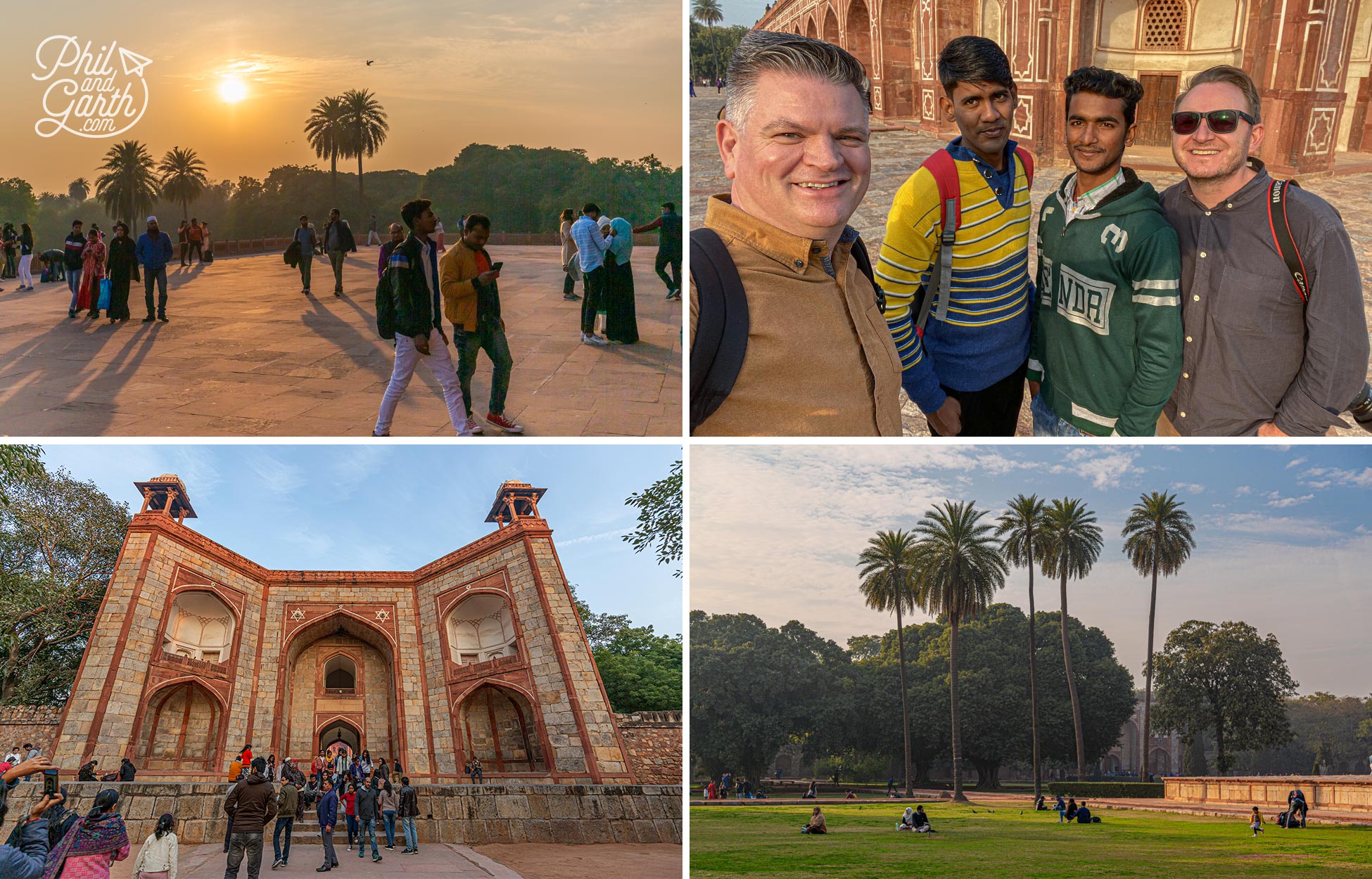
Making new friends with the locals at Humayun’s Tomb
We both loved the gardens here, especially Garth because he loves Islamic paradise gardens and this one is a perfect example. After you’ve visited the inside of the mausoleum take your time and wander around the grounds which are lush and immaculately maintained. We saw lots of Indian families and very few western tourists. We got asked lots of times by people to have our photo taken with them! We didn’t realise at the time, this was to be the first of many ‘photoshoots’ on our tour of India! In fact the people watching here is brilliantly entertaining – so many people were rocking their best poses for Instagram and TikTok.
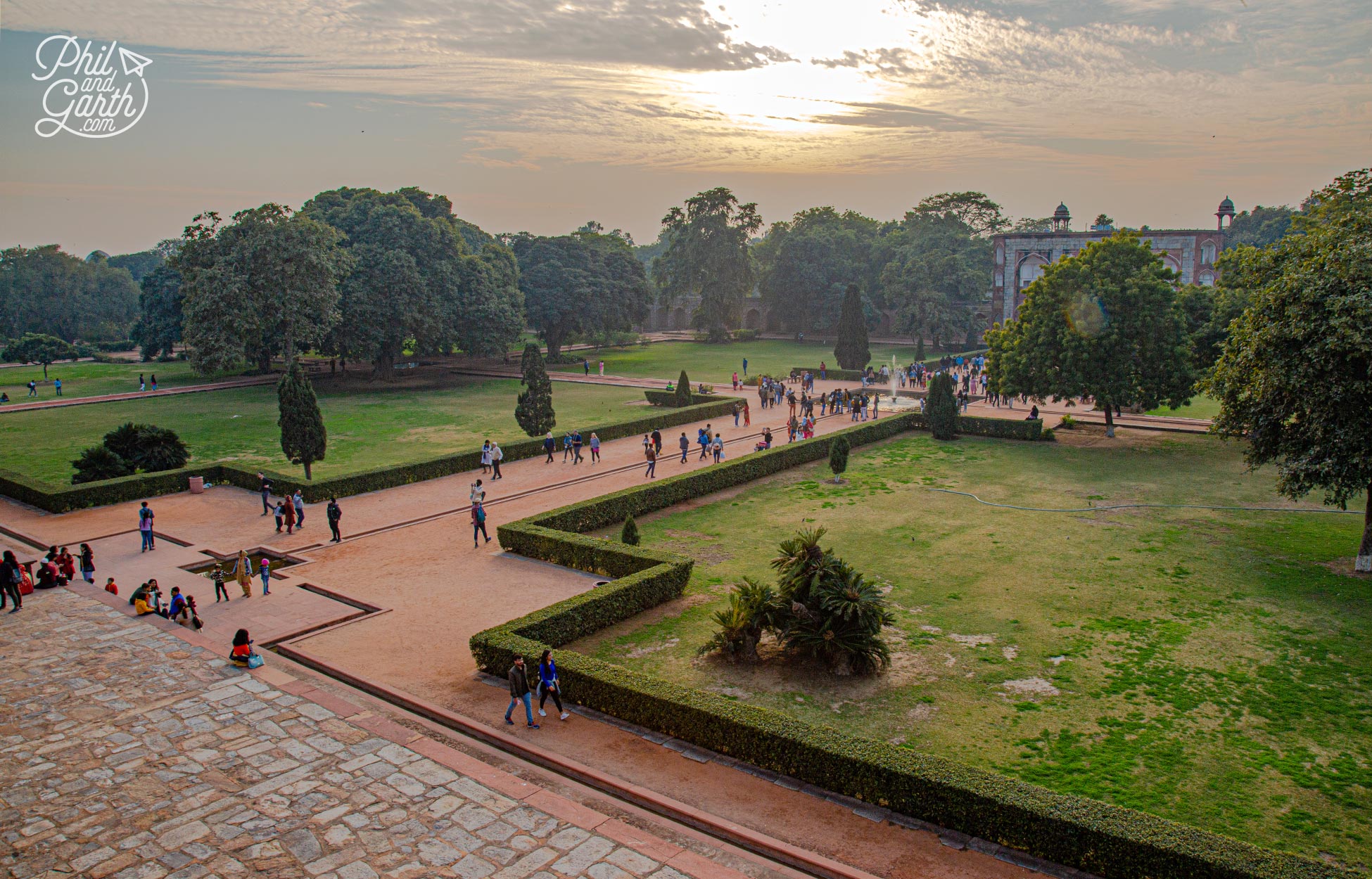
Humayun’s Tomb paradise garden – typically divided into 4 squares with central water channels
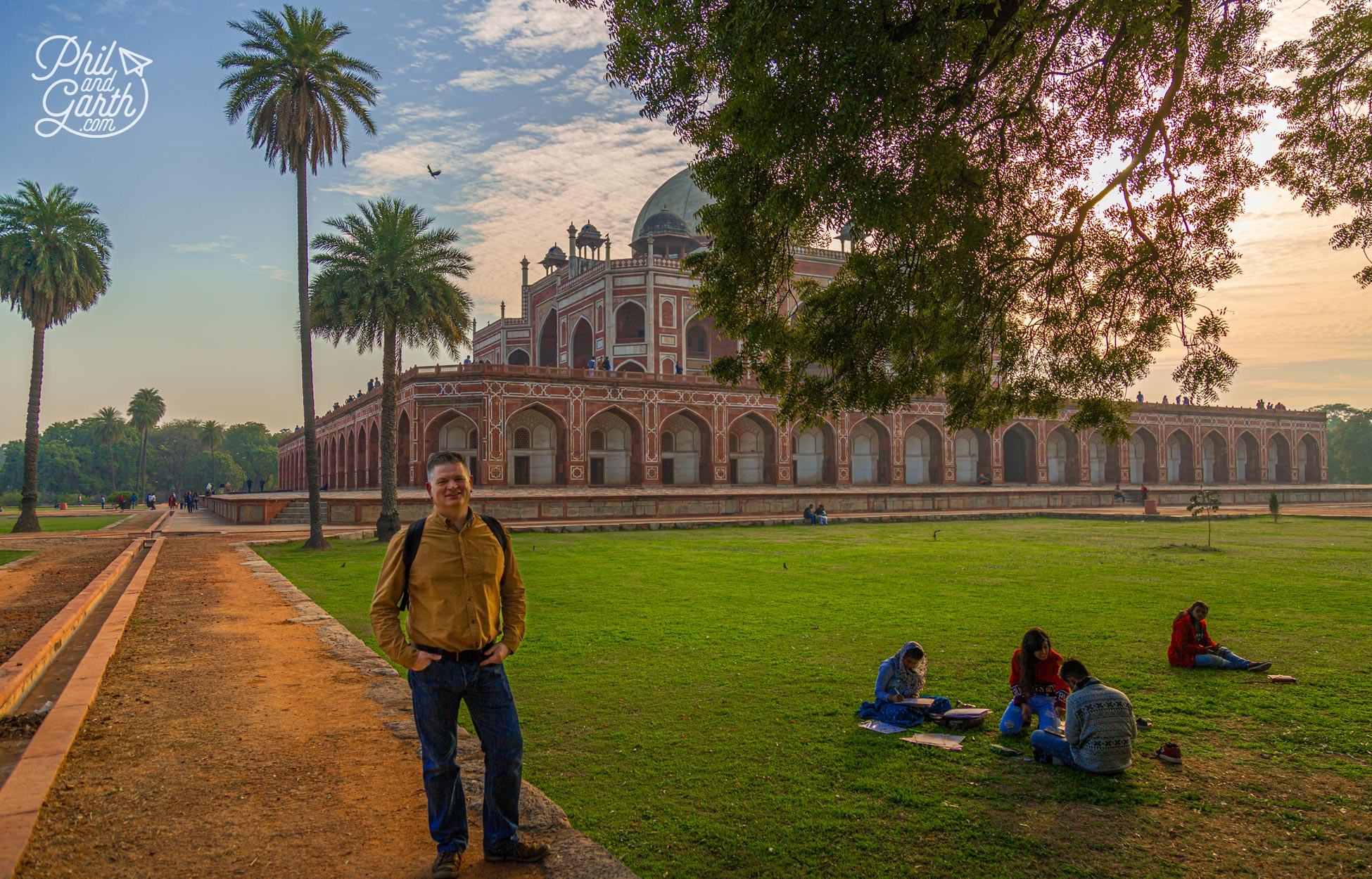
Phil strolling around the tranquil gardens of Humayun’s Tomb
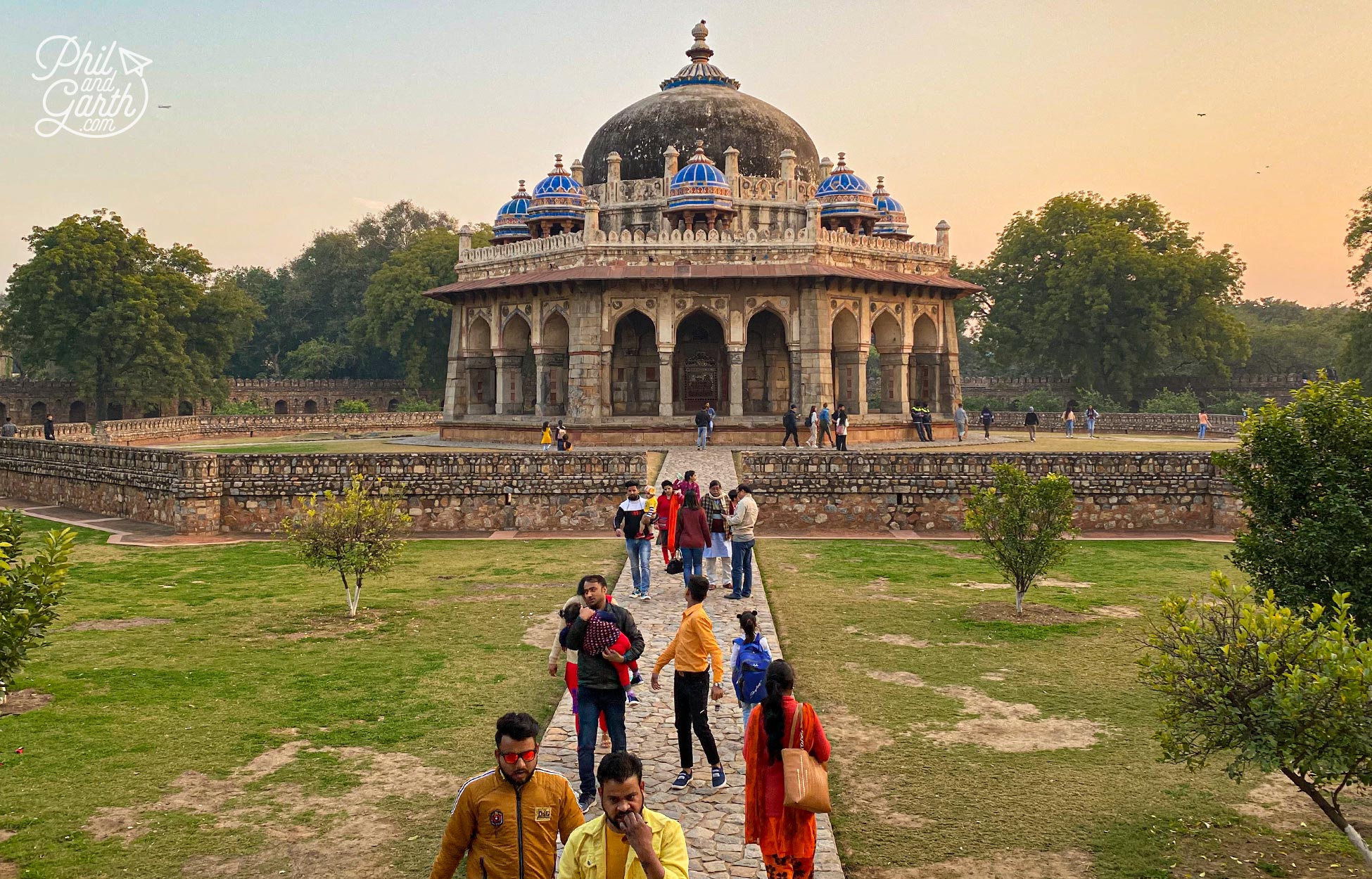
Tomb of Isa Khan in the grounds of Humayun’s Tomb
We visited late in the day before they close at 6pm so the low light was gorgeous, especially inside with shadows cast from the patterns of the lattice stone windows. When you’re done get a tuk tuk (don’t forget to barter!) to the Lotus Temple which is 4 miles away. We left it too late in the day to visit so had to settle for seeing one of Delhi’s iconic landmarks through the fence.
Getting To Old Delhi by Metro
The next morning we started early and got on the underground. The Delhi Metro system is incredible – it’s modern, efficient, air conditioned and really cheap for getting around. Platforms even have tv screens telling you what the pollution levels are like outside. The train carriages are not too cramped either.
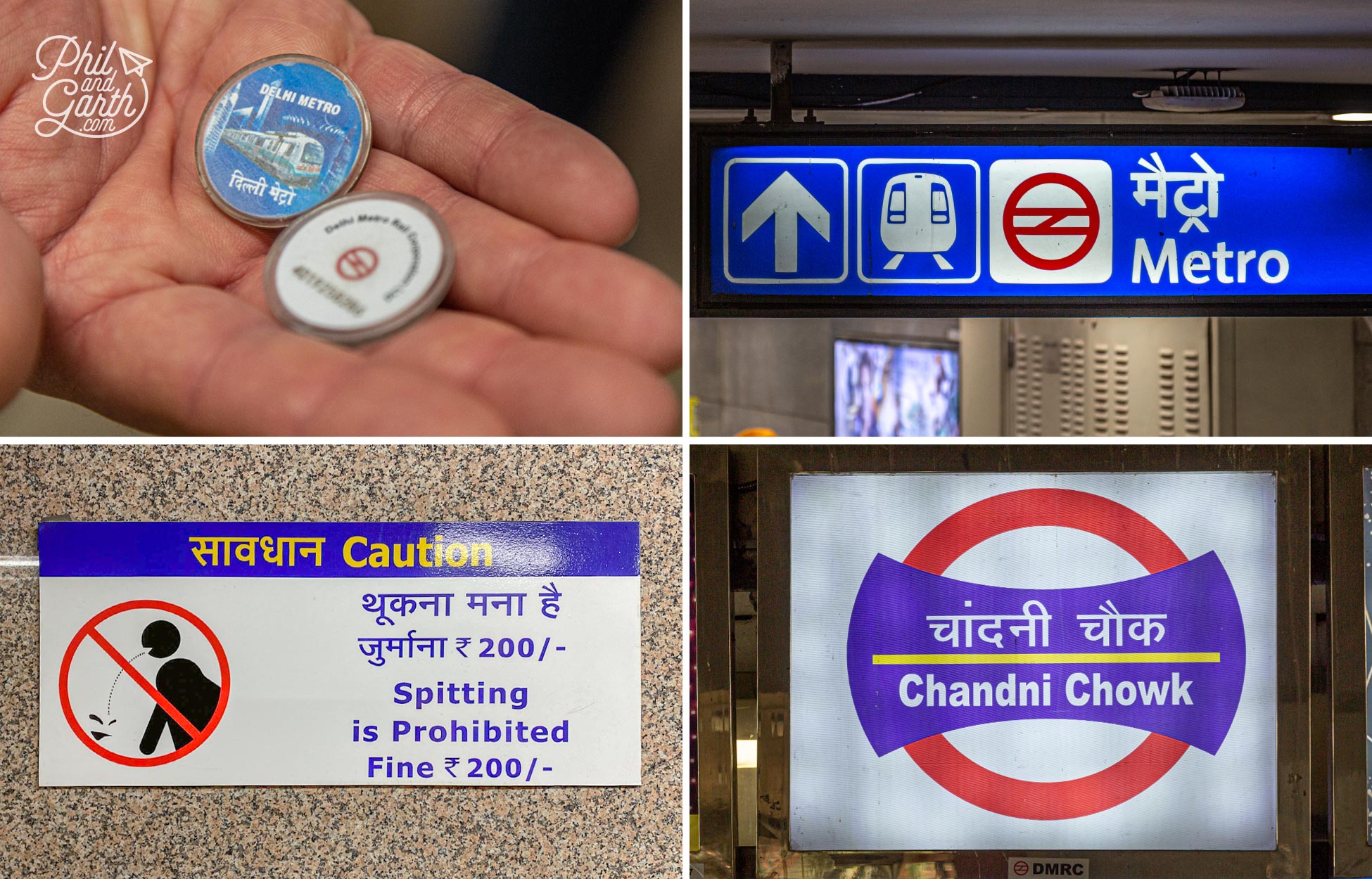
Delhi Metro tokens and signs on the underground
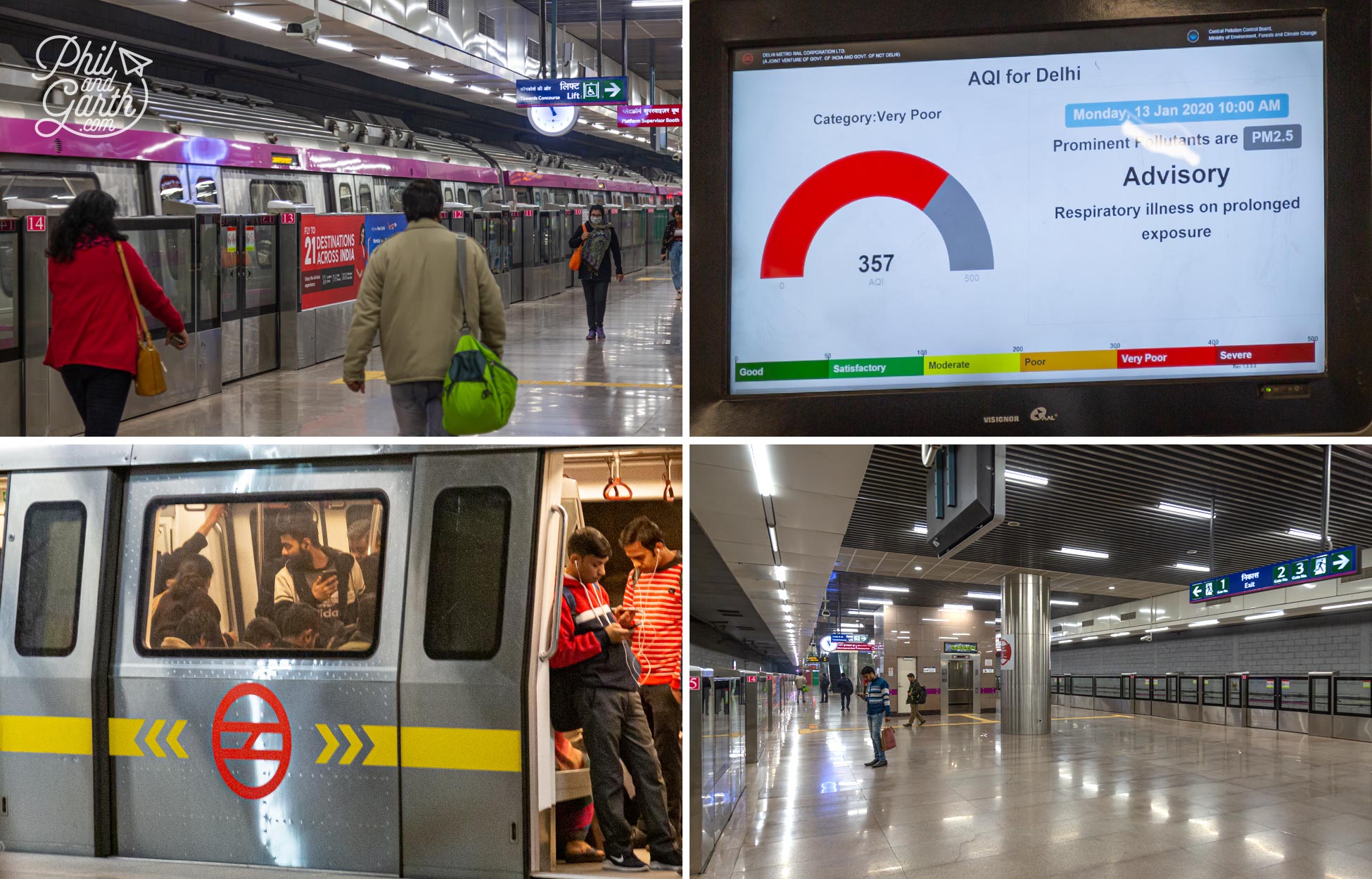
The Delhi Metro has won awards for its environmentally friendly construction
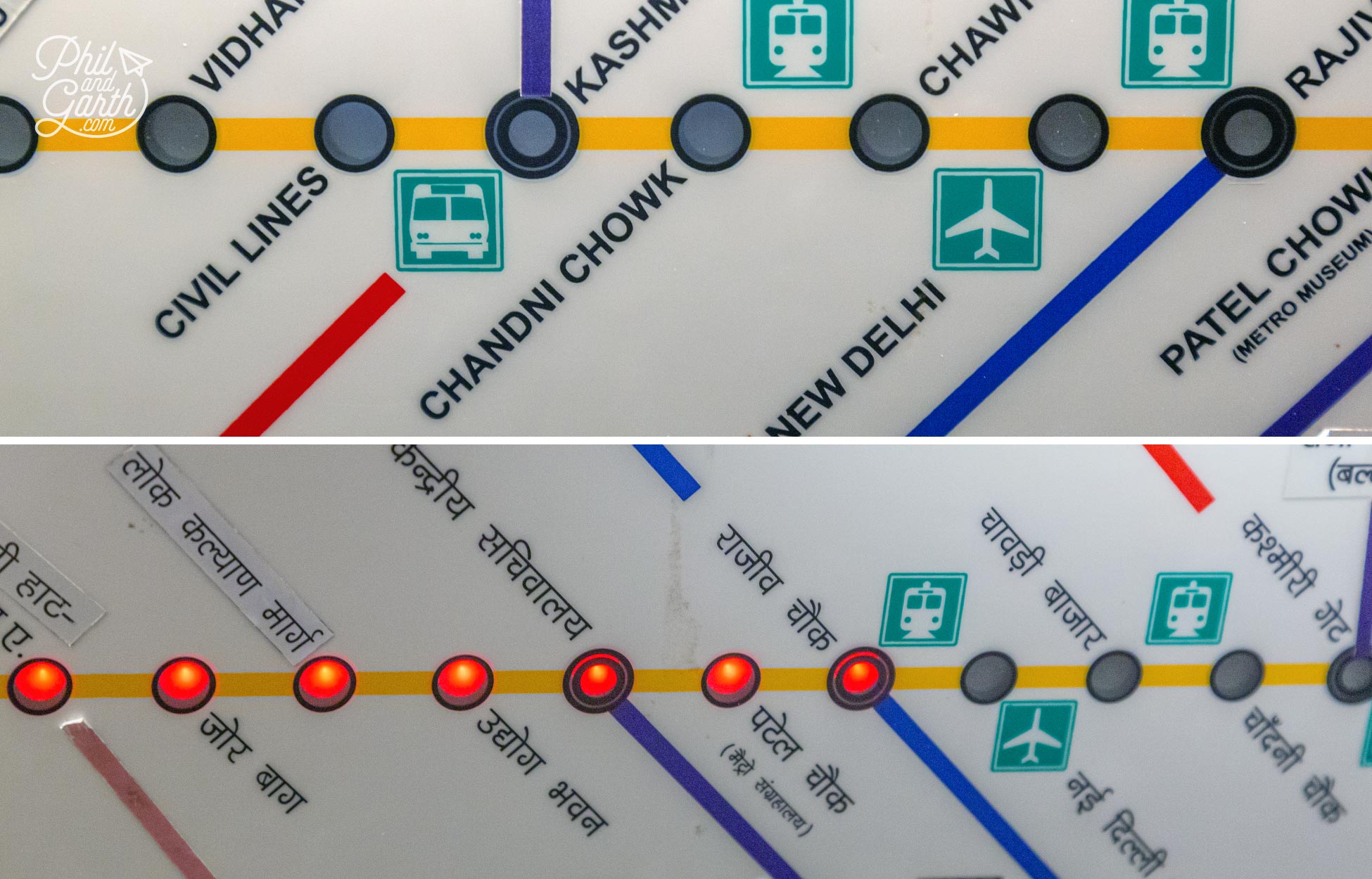
The Delhi Metro is easy to use as signs are in both Hindi and English onboard the trains
Chandi Chowk Market
We arrived at the Chandi Chowk Metro stop in Old Delhi, as you exit the station get ready for a culture shock! It’s crowded, people ask you for money, men are constantly spitting or weeing in roadside drains whilst cows wander around eating bits of rubbish that people just chuck on the floor. We looked inside a Hindu temple next to the station where they were feeding the poor hearty meals, lovely to see there is also a lot of good in India.
Before we knew it we were on our rickshaw ride through the Chandi Chowk Market. Wow, it’s one heck of an experience full of unusual sights, it feels like stepping back in time. Chandi Chowk is crazy busy with people, rickshaws, motorbikes and cows all jostling for space. It looks like absolute chaos, but the reality is everyone are just going about their daily life. Yes it’s dirty but there is beauty in all this mayhem. The exotic smells from the different street food carts, the smiles back from people and the energy about the place gave us a real buzz. However we could imagine it could be stressful and overwhelming for some people.
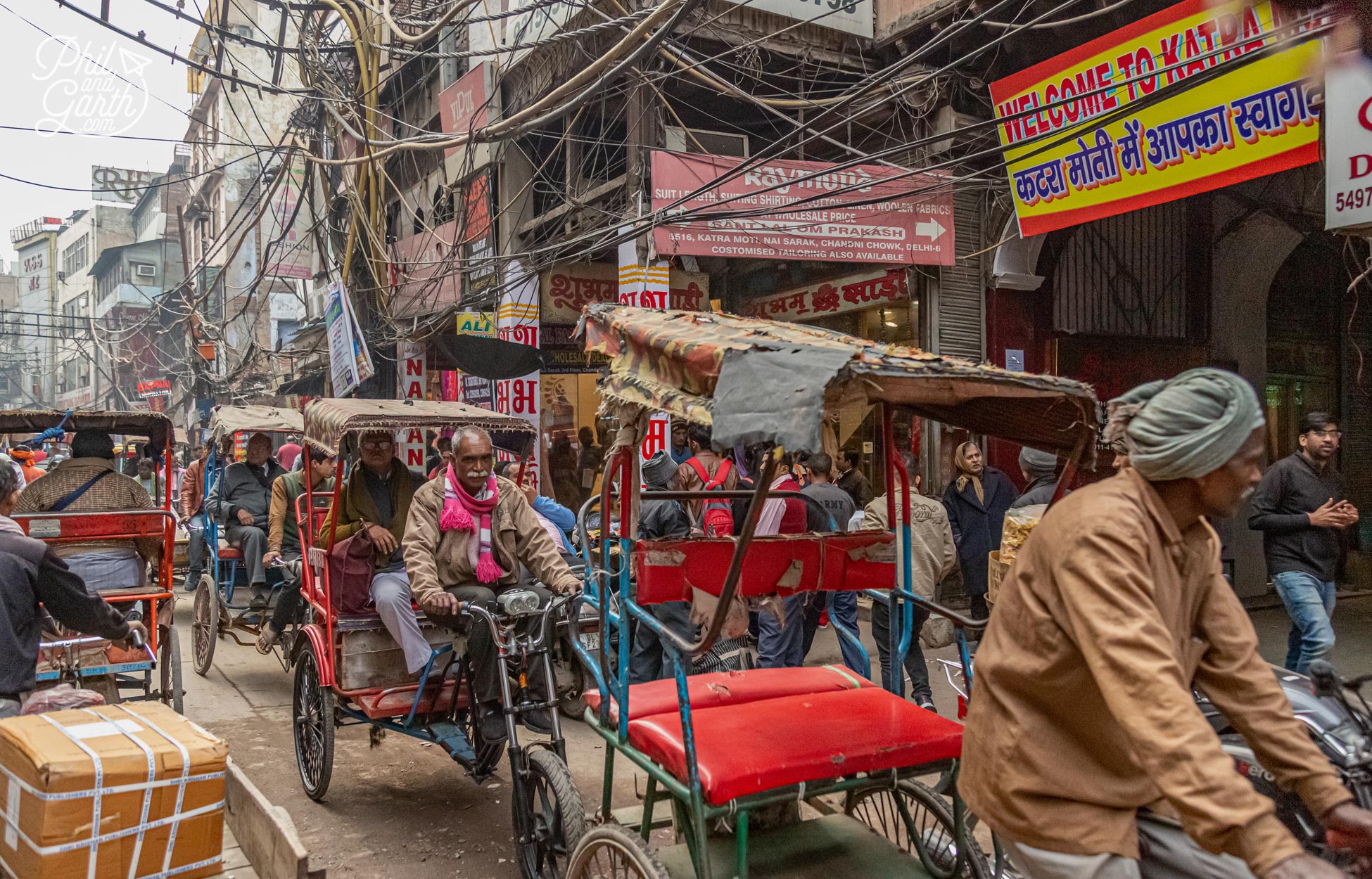
The Chandi Chowk Market really has to be seen to be believed
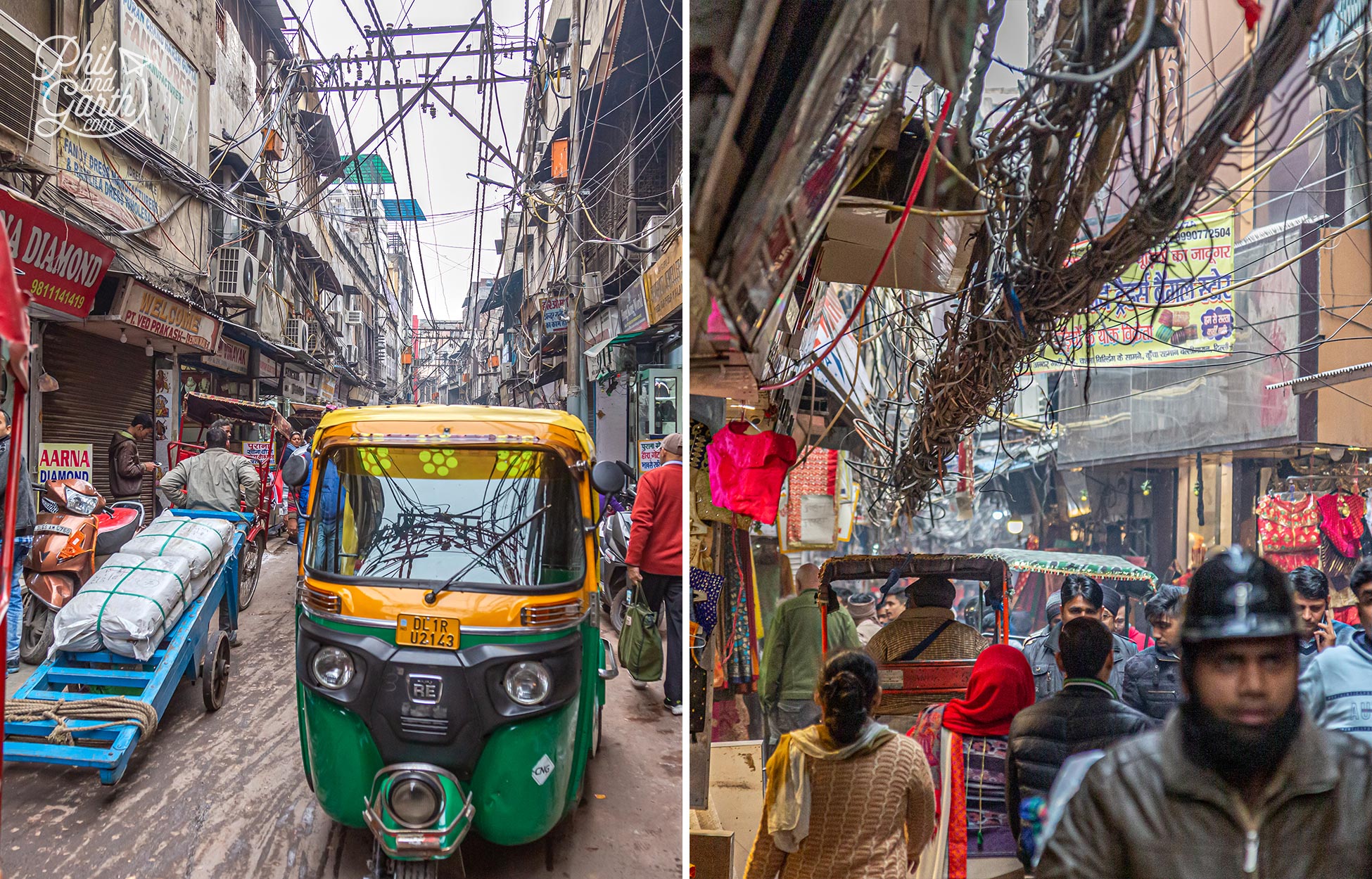
Take a deep breath and keep all your body parts within the rickshaw
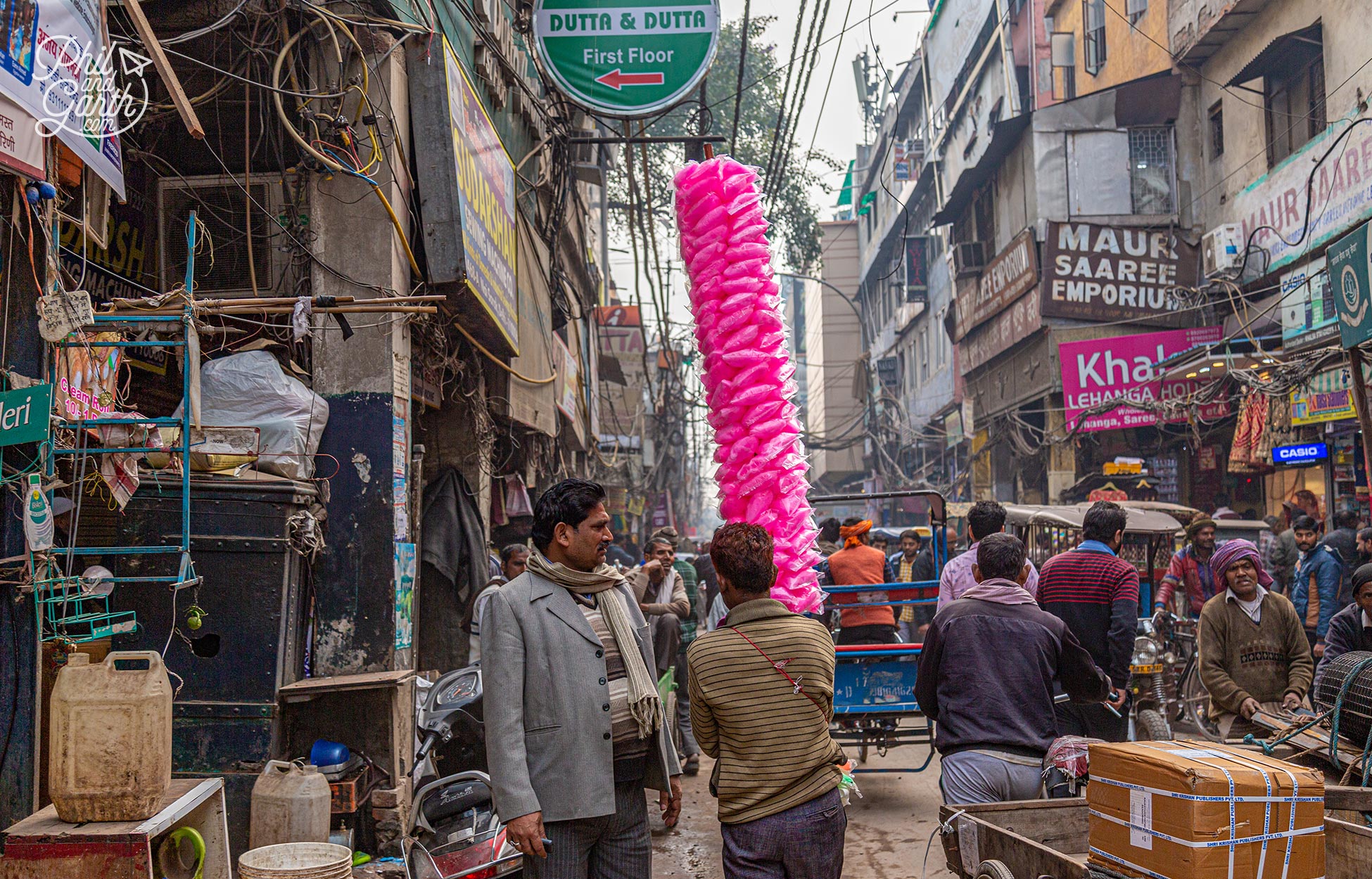
It was an unforgettable experience riding through the lanes
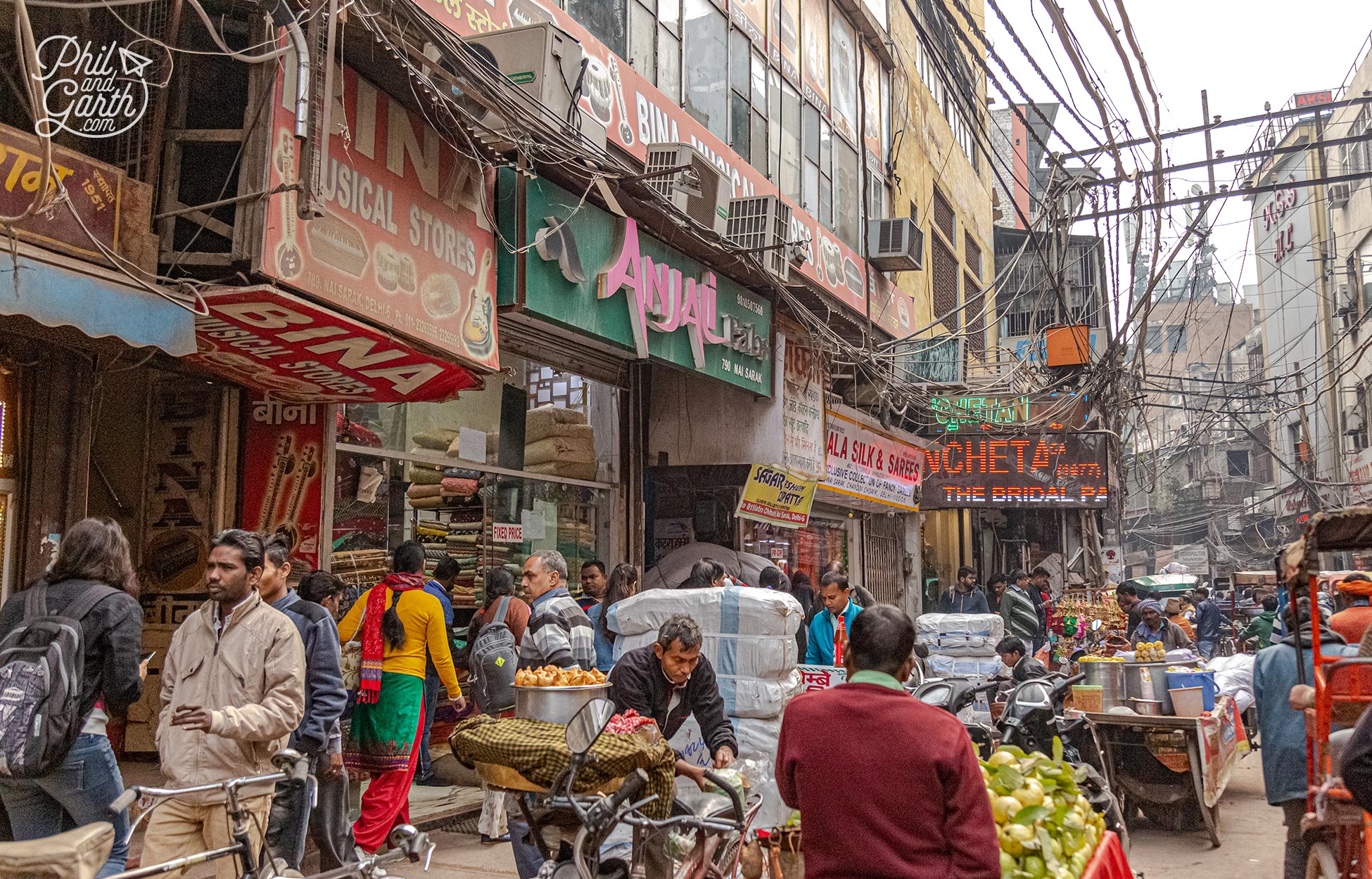
Rickshaws, bikes, people even cows narrowly avoid collision
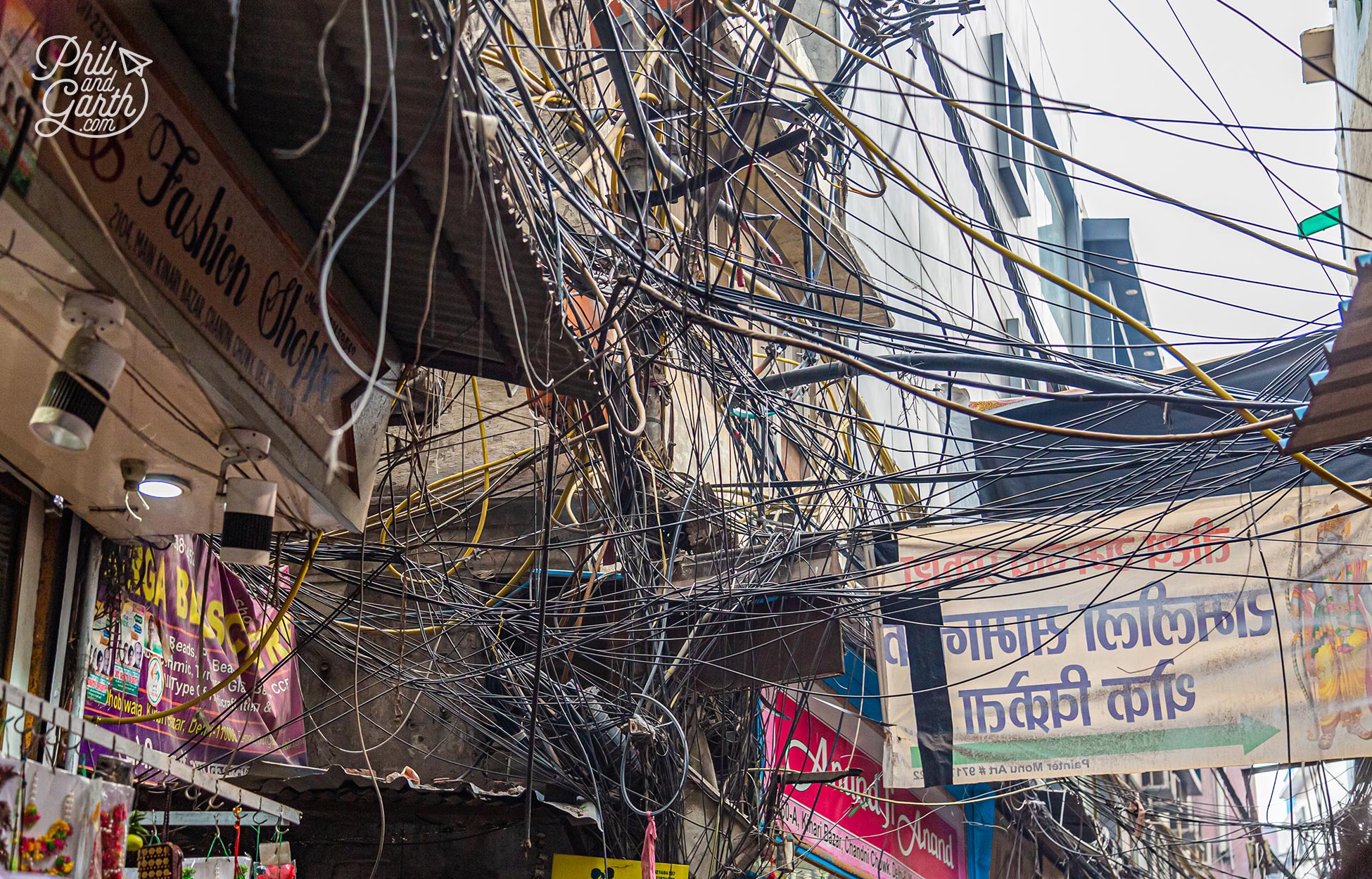
Check out that tangle of wires
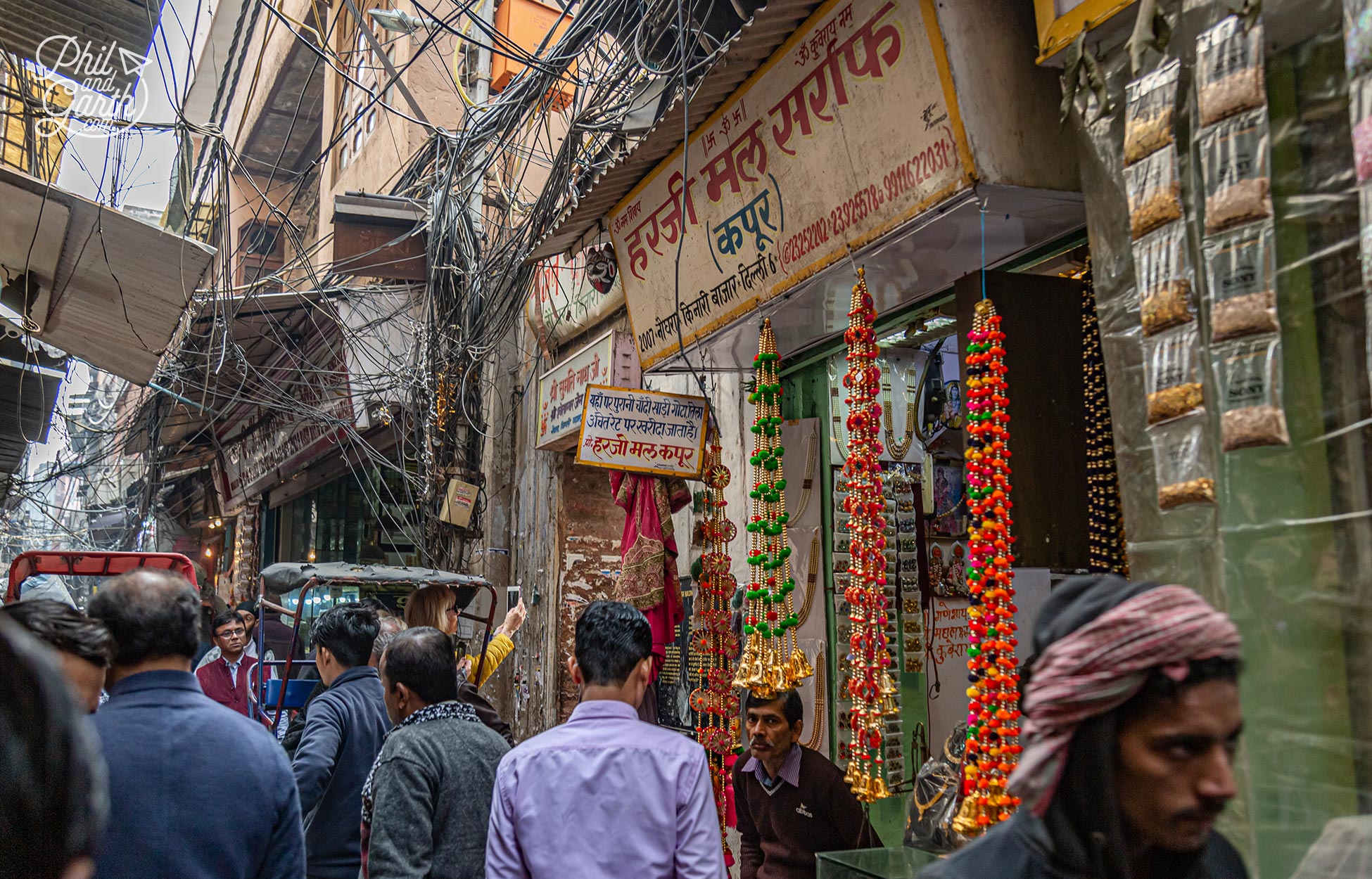
The market is a labyrinth of narrow streets
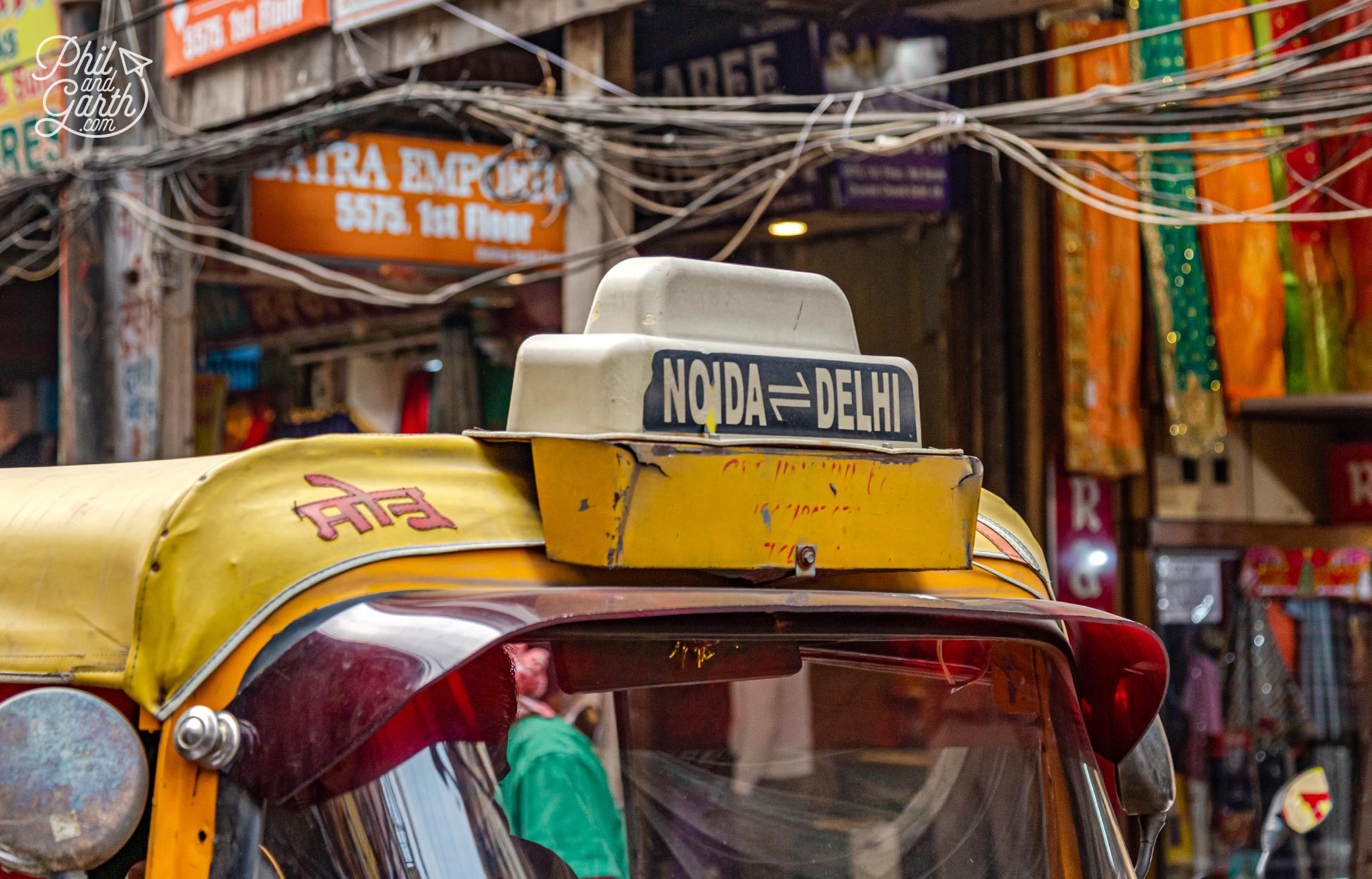
Streets are themed according to the goods they sell
Chandi Chowk is Delhi’s oldest and biggest market and it sells everything. Shops are tightly packed with different goods. From colourful saris and textiles to jewellery or electrical goods – you name it and it’s here. Our rickshaw driver took us around the bridal shops and other some other streets selling decorations and offerings for Hindu gods. It reminded us a bit of Hanoi’s Old Quarter in Vietnam where the streets are themed according to the goods they sell. Phil being an engineer couldn’t get over the mess of tangled electric wires everywhere. He thought Bangkok was bad, but these tangles are on another level!
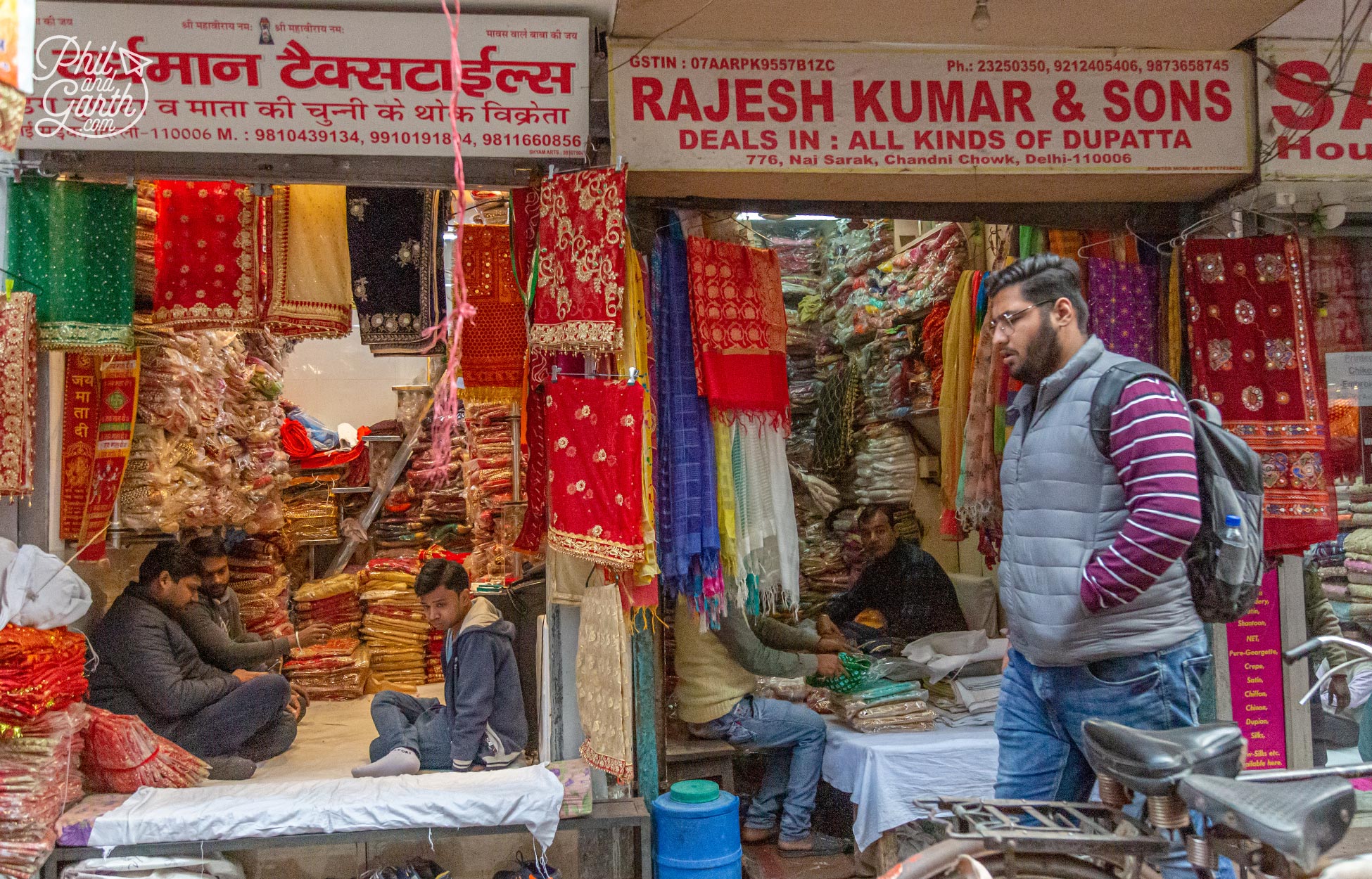
If you want to buy stuff – expect to haggle sometimes up to half the quoted price
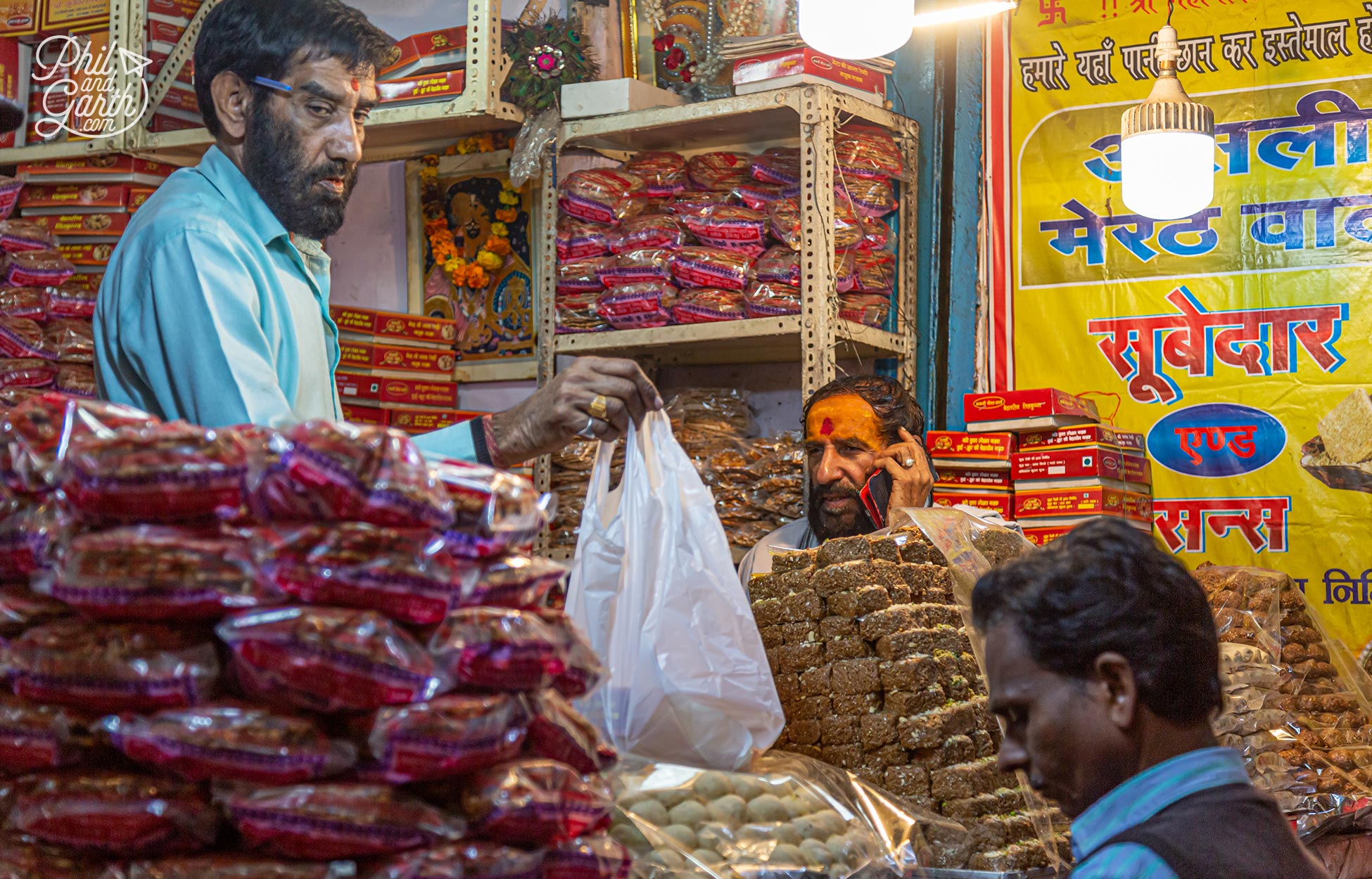
Weekdays are quieter than weekends – can’t imagine how busy the weekends must be!
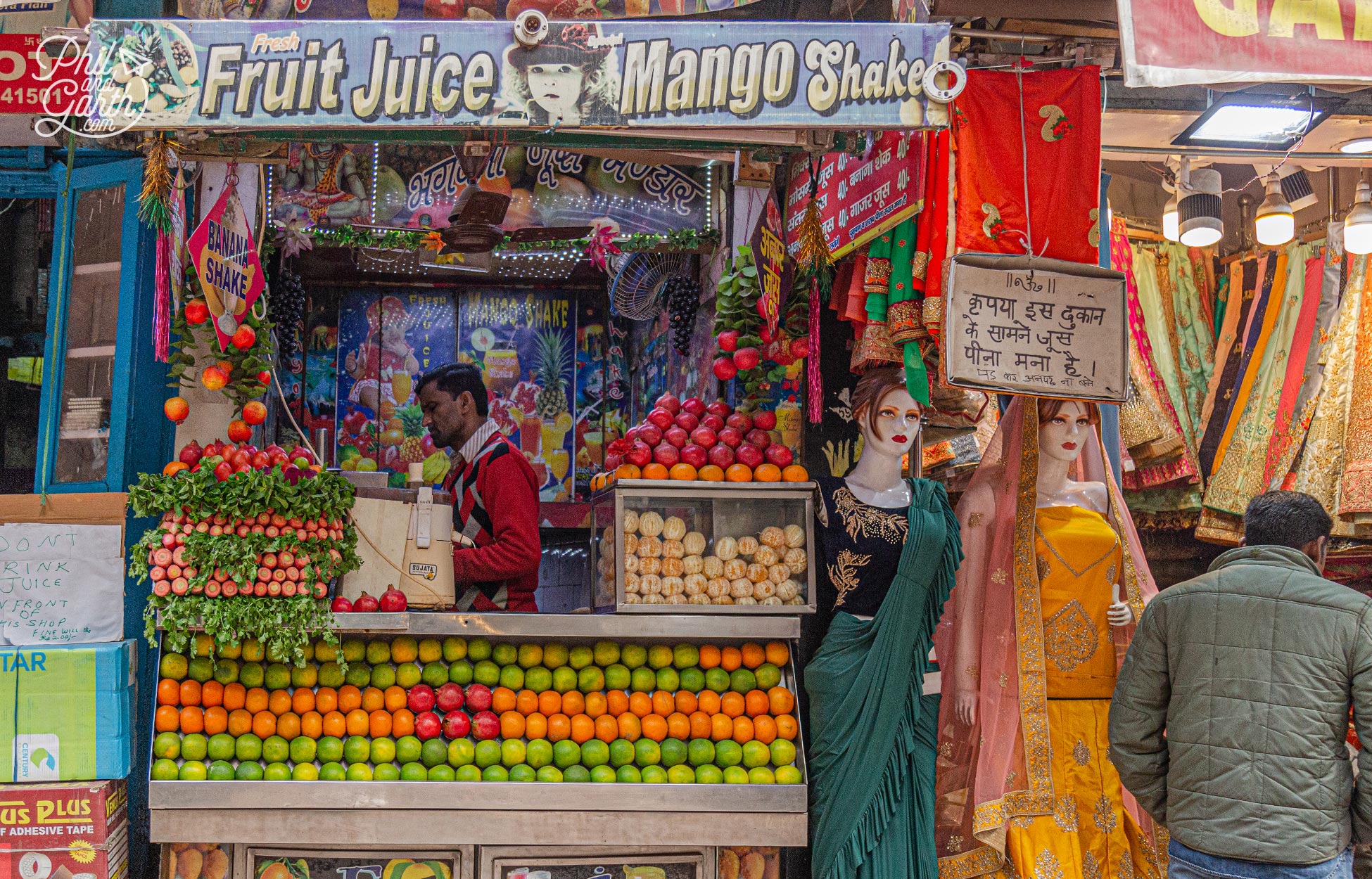
Garth was in his element photographing all the colourful sights
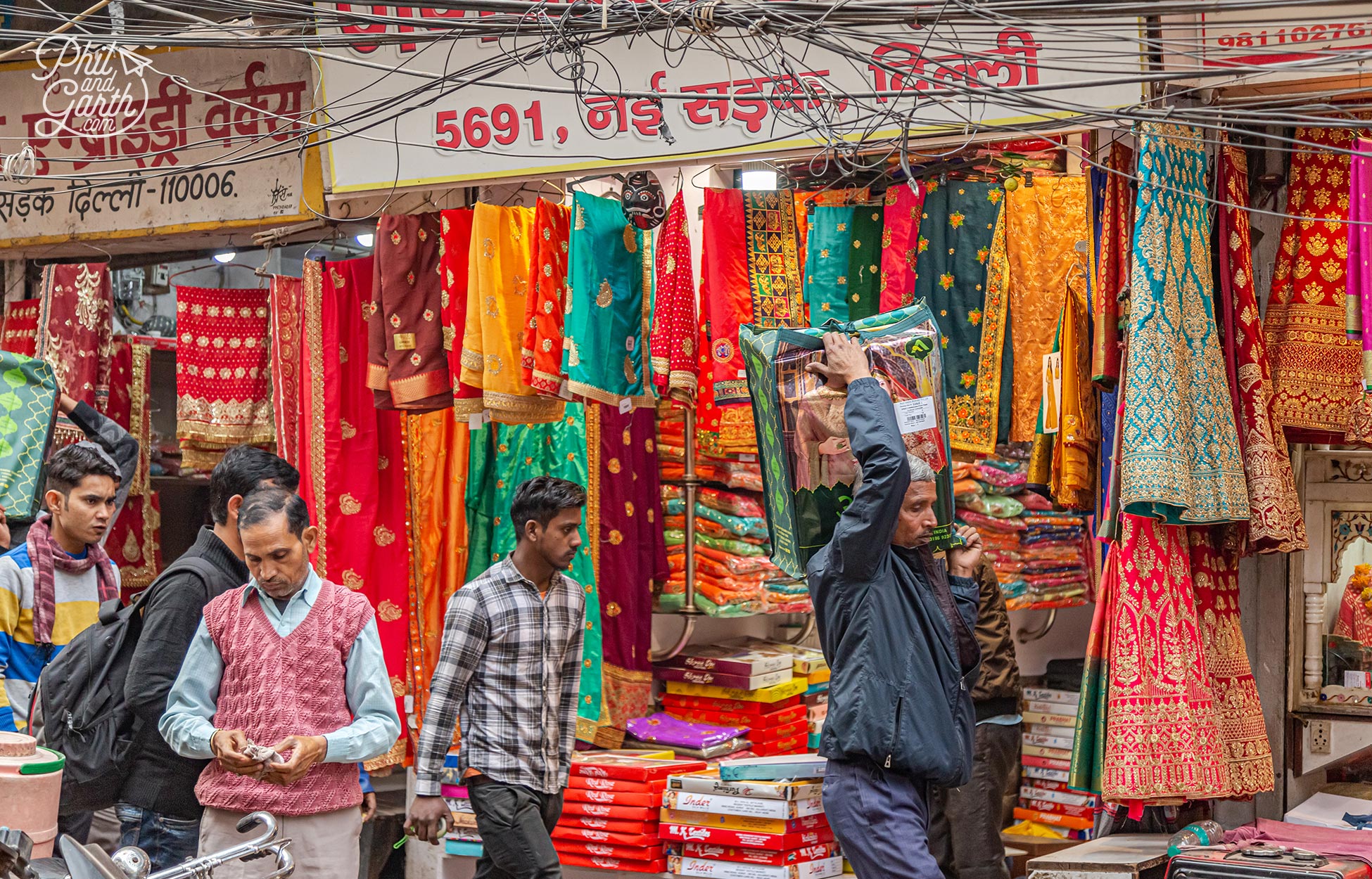
Chandi Chowk is a visual feast for the eyes!
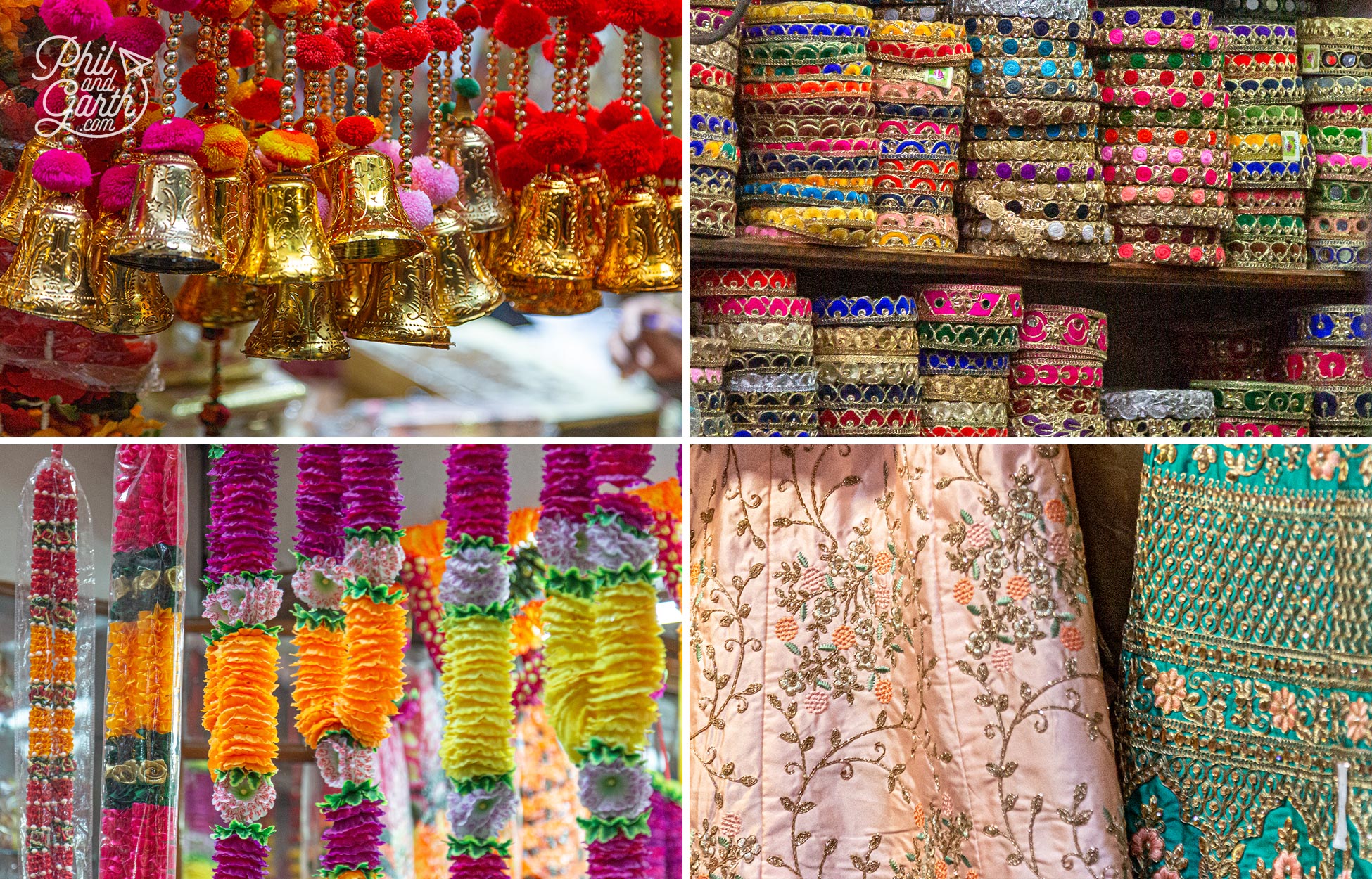
So much colour, texture and bling!
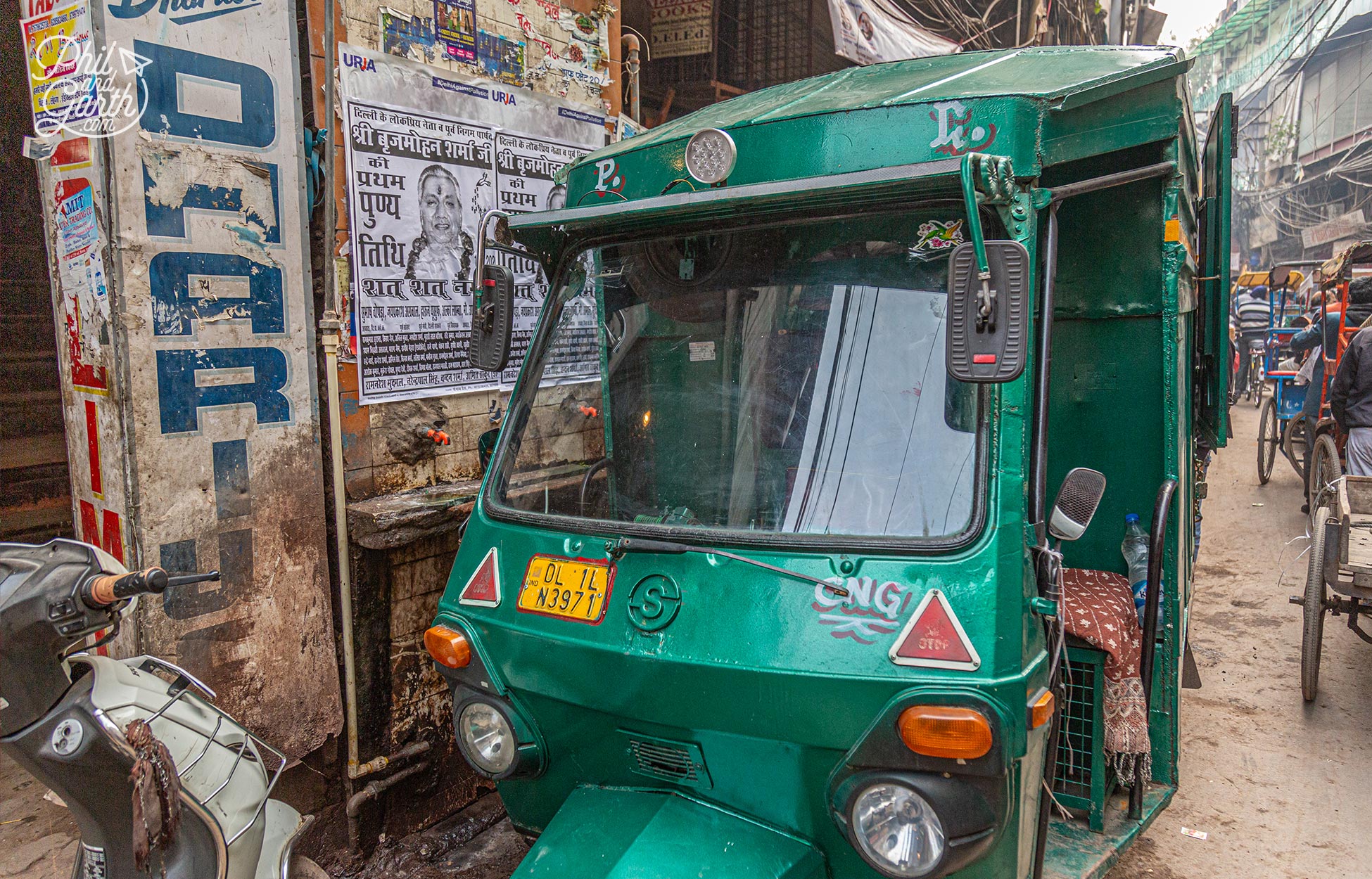
Chandi Chowk market is closed on Sundays
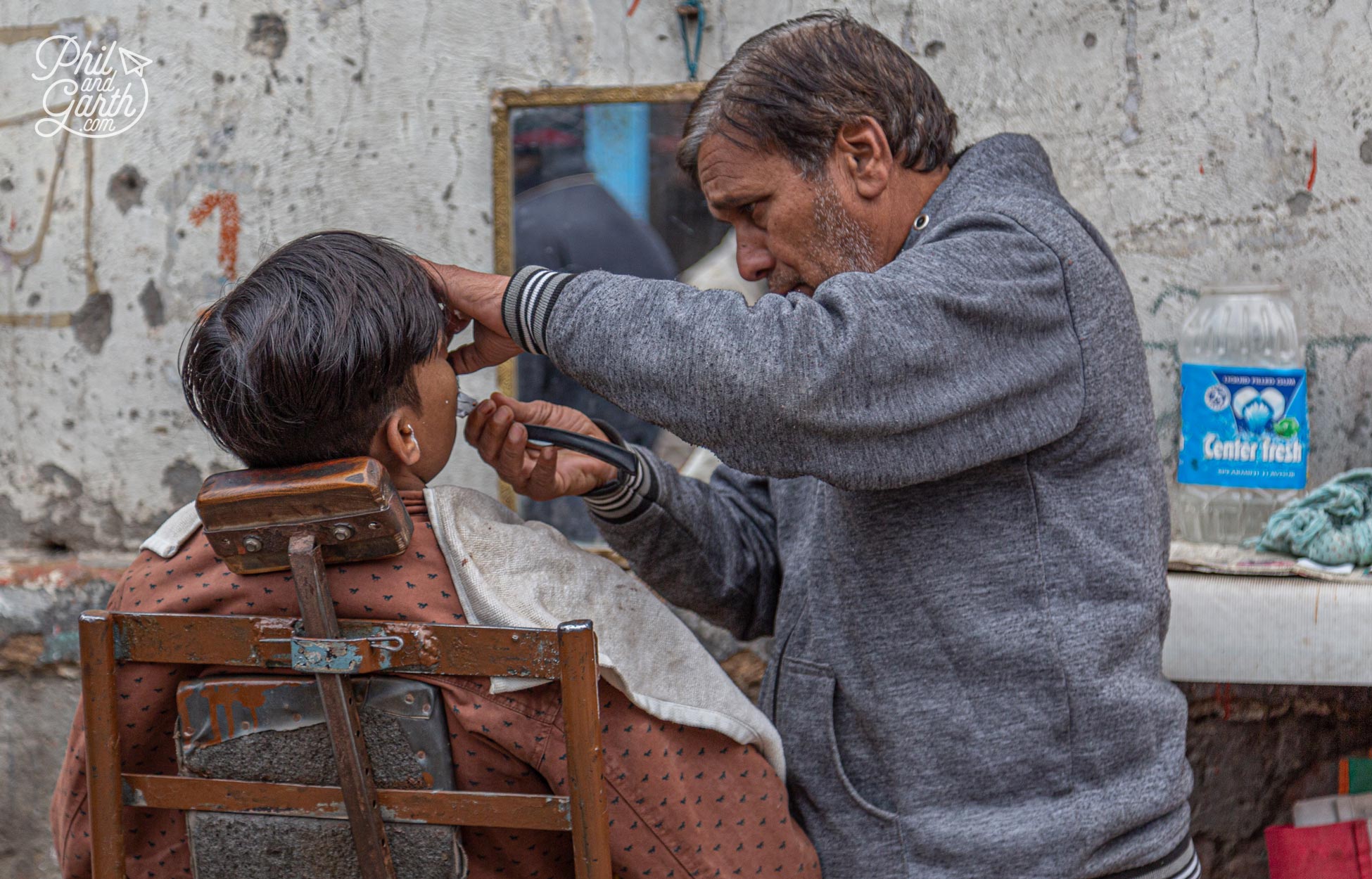
We even spotted an outdoor barbers shop
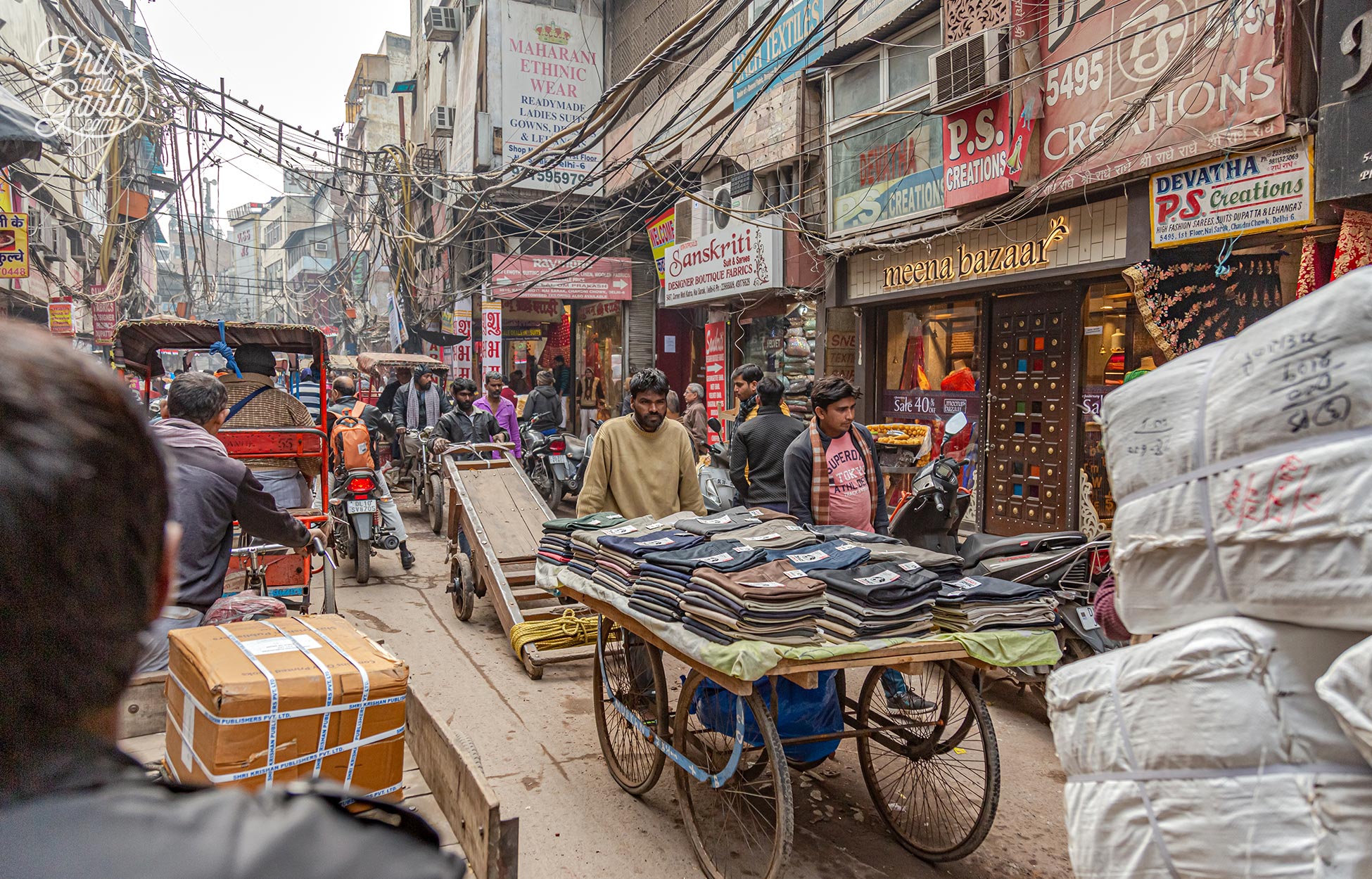
Our guide said Karim’s is great for traditional Mughal food, it’s been in the market for over 100 years
The Chandi Chowk Market will definitely go down on our list of life experiences. We love trying new things and we enjoyed the market. It’s certainly authentic Old Delhi. If we had more time we would have visited the spice market Khari Baoli next to Chandi Chowk. It’s Asia’s largest wholesale spice market. It was these spice markets that once connected India with the West.
Jama Masjid Mosque
A 10 minute walk from Chandi Chowk Market is Delhi’s largest mosque – Jama Masjid. It’s also one of the biggest in India (Taj-ul-Masajid in Bhopal is the biggest). Completed in 1656, Jama Masjid is dramatic with 3 huge red sandstone gates, 3 white marble domes and 2 main towering minarets. The large courtyard can accommodate 25,000 people. It was commissioned by Emperor Shah Jahan who also built the Taj Mahal in Agra for his wife.
It’s free to enter the courtyard but there is a fee for photography 300 INR (£3.10). Everyone must take off their shoes and you can pay the guy at the gate to look after your shoes 10 INR (10p). Women must dress modestly and cover their legs and shoulders whilst men can’t wear shorts to enter. You can hire robes if you’re not suitably dressed.
Inside the courtyard it had a powerful feeling as we could feel the chants reverberate through our body from the huge speakers everywhere. Guides who offer their services in the courtyard are fake – so just ignore them.
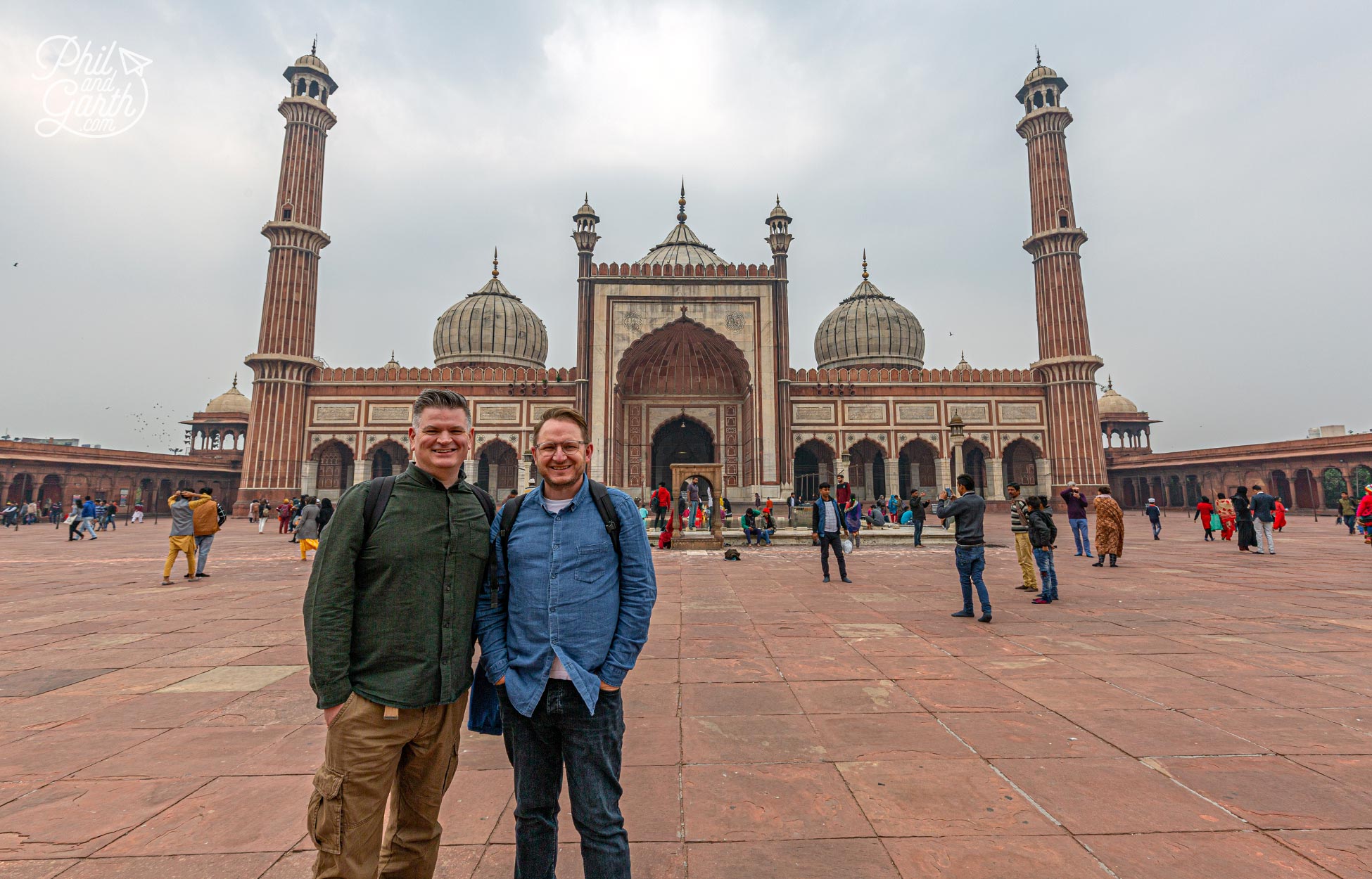
The elegant Jama Masjid Mosque was built in 1656 – it’s incredibly old!
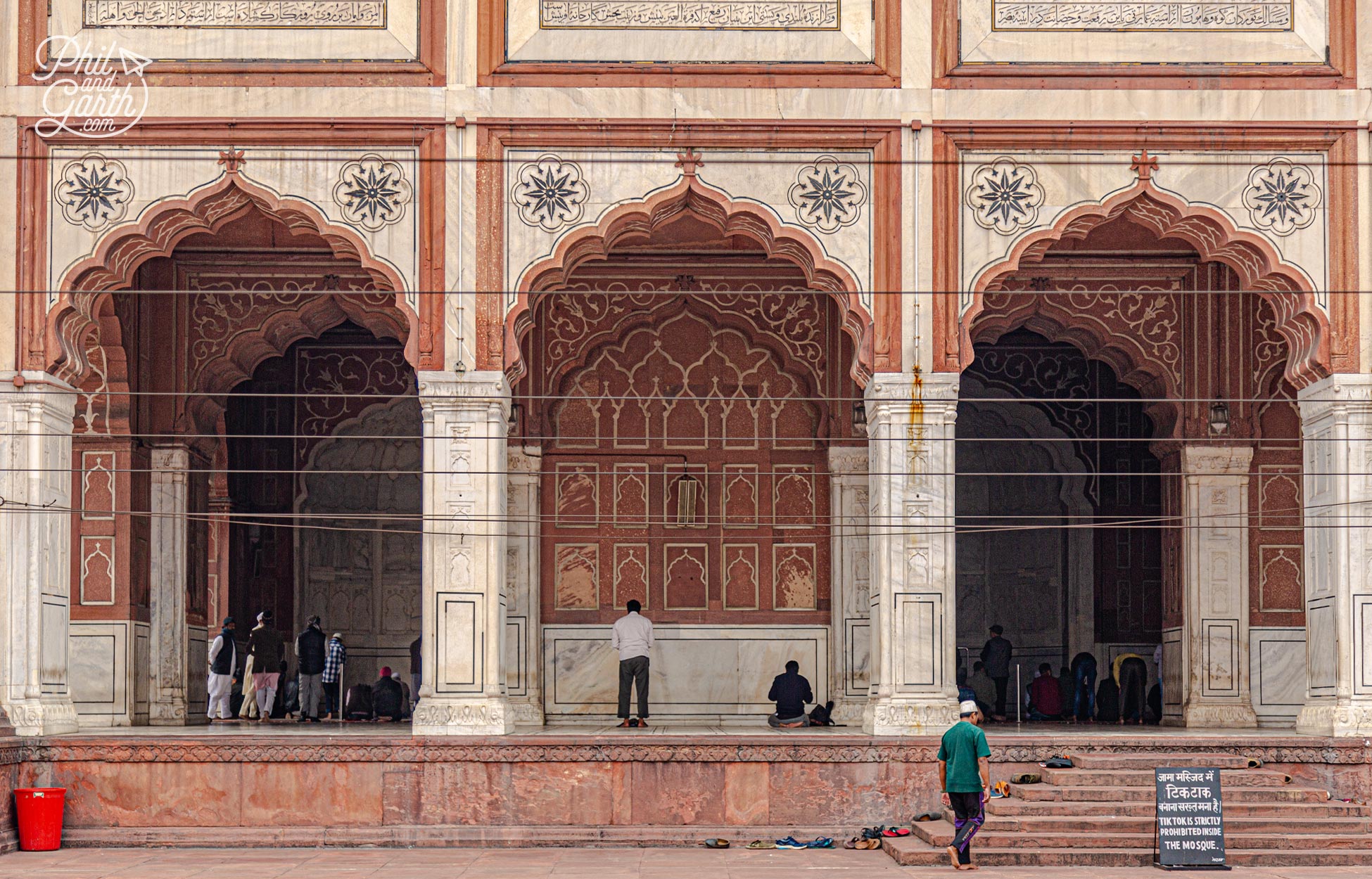
The exterior is beautiful – so much detail in the white marble and red sandstone
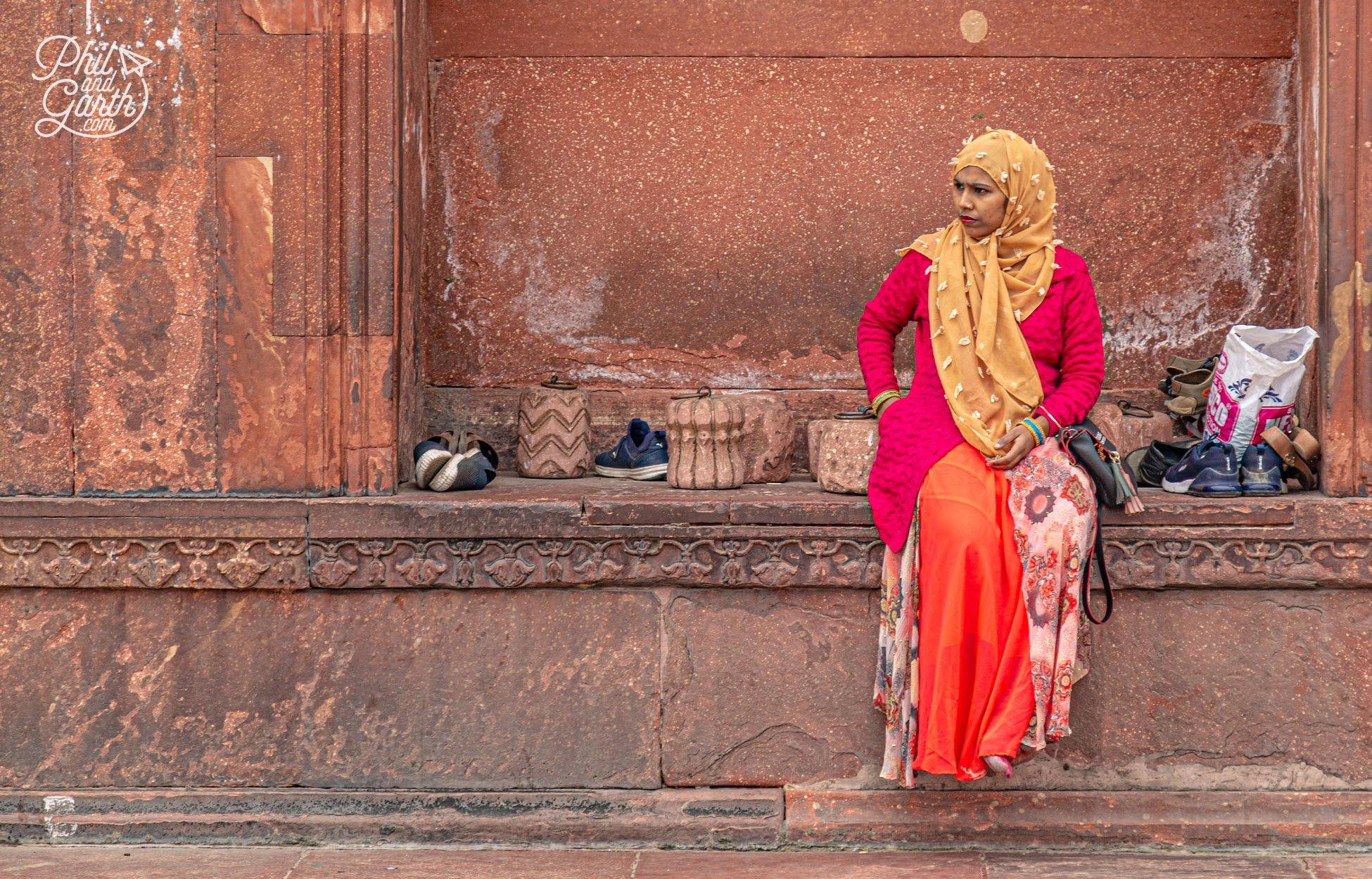
Tourists are not allowed to enter the mosque during prayer times
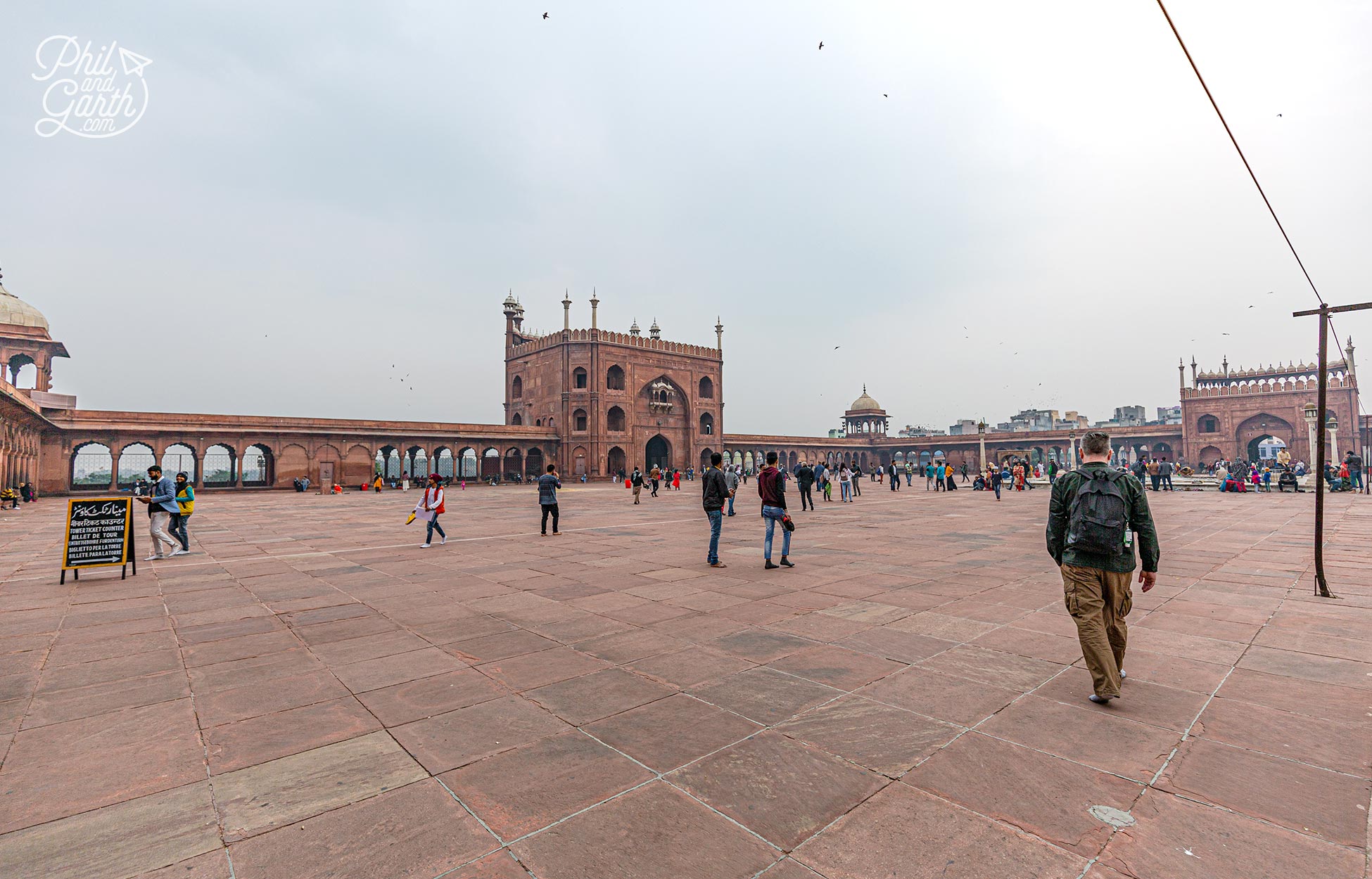
The huge courtyard can accommodate 25,000 people
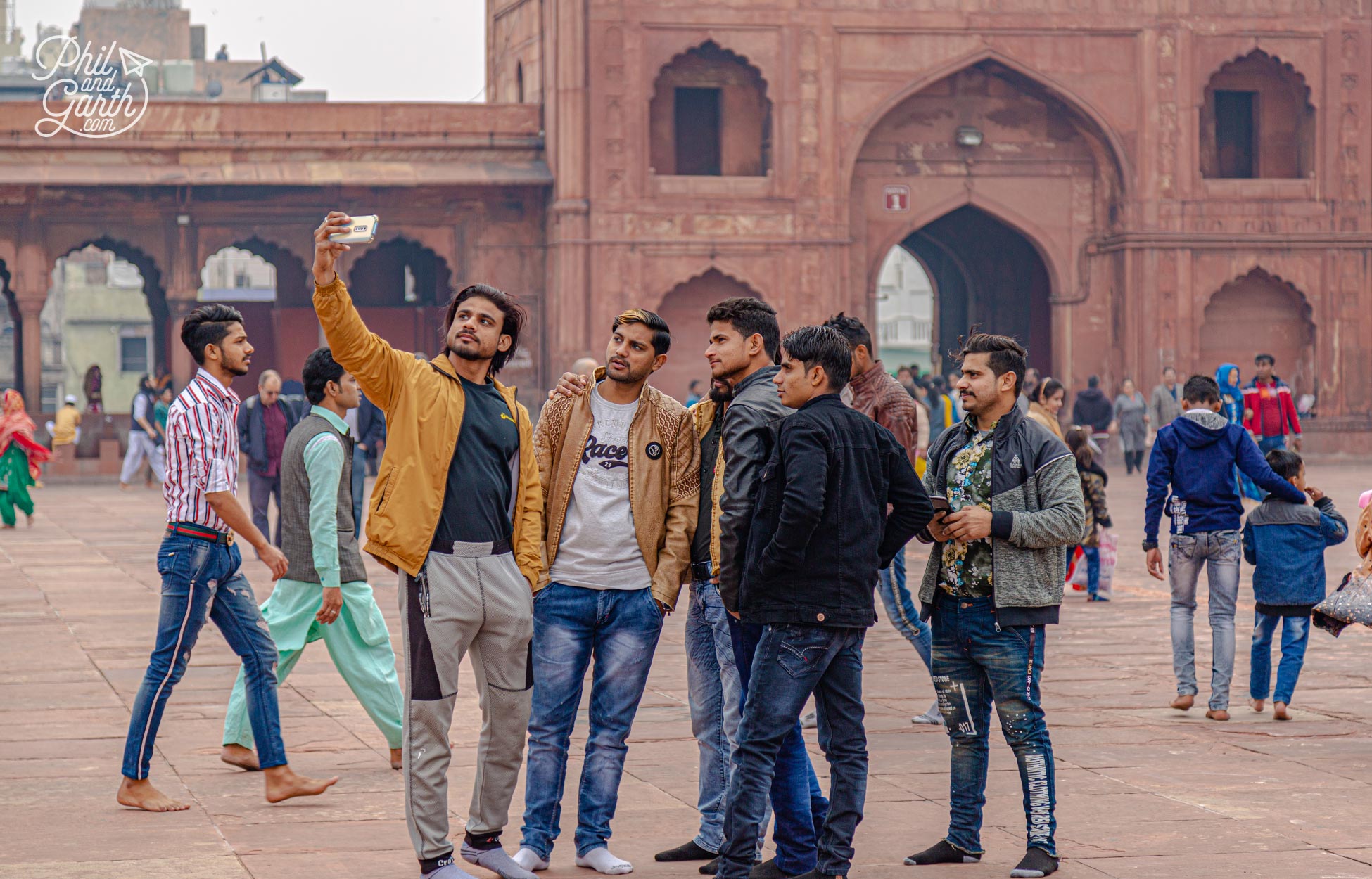
So many people taking selfies in the courtyard, including with us occasionally
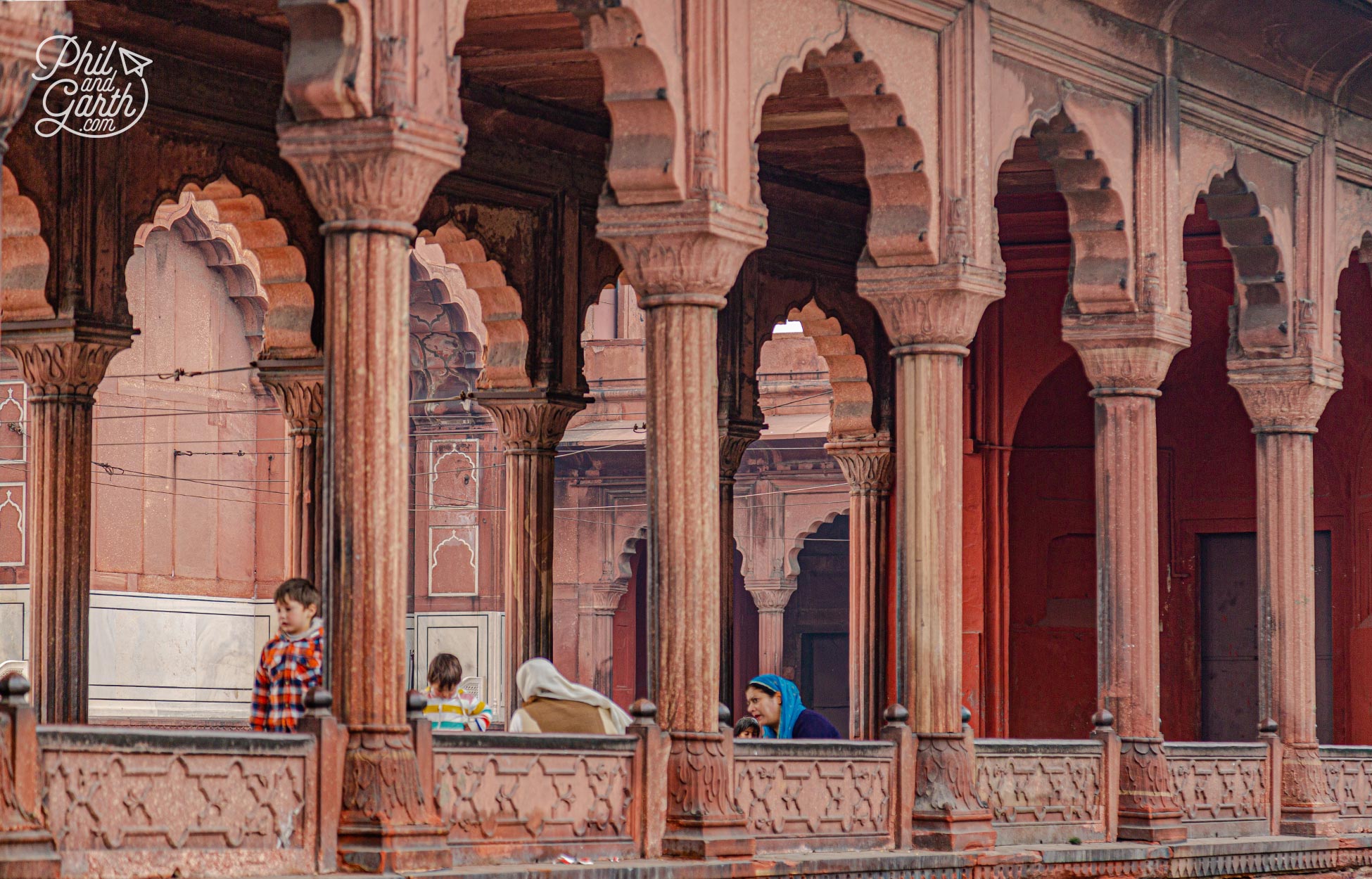
It’s so peaceful inside the courtyard compared to the noise and chaos outside on the streets
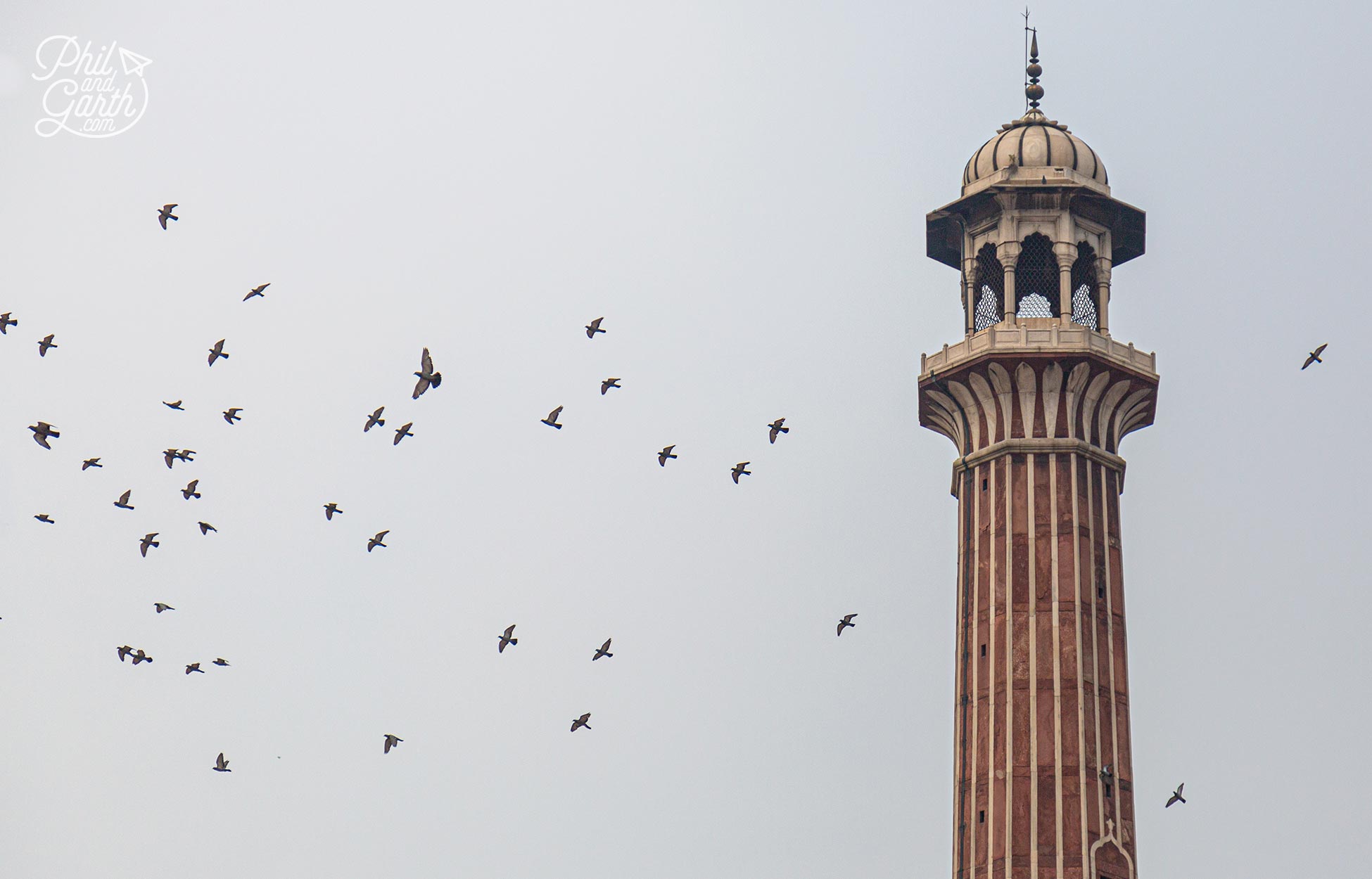
The hundreds of pigeons flying around make dramatic photographs
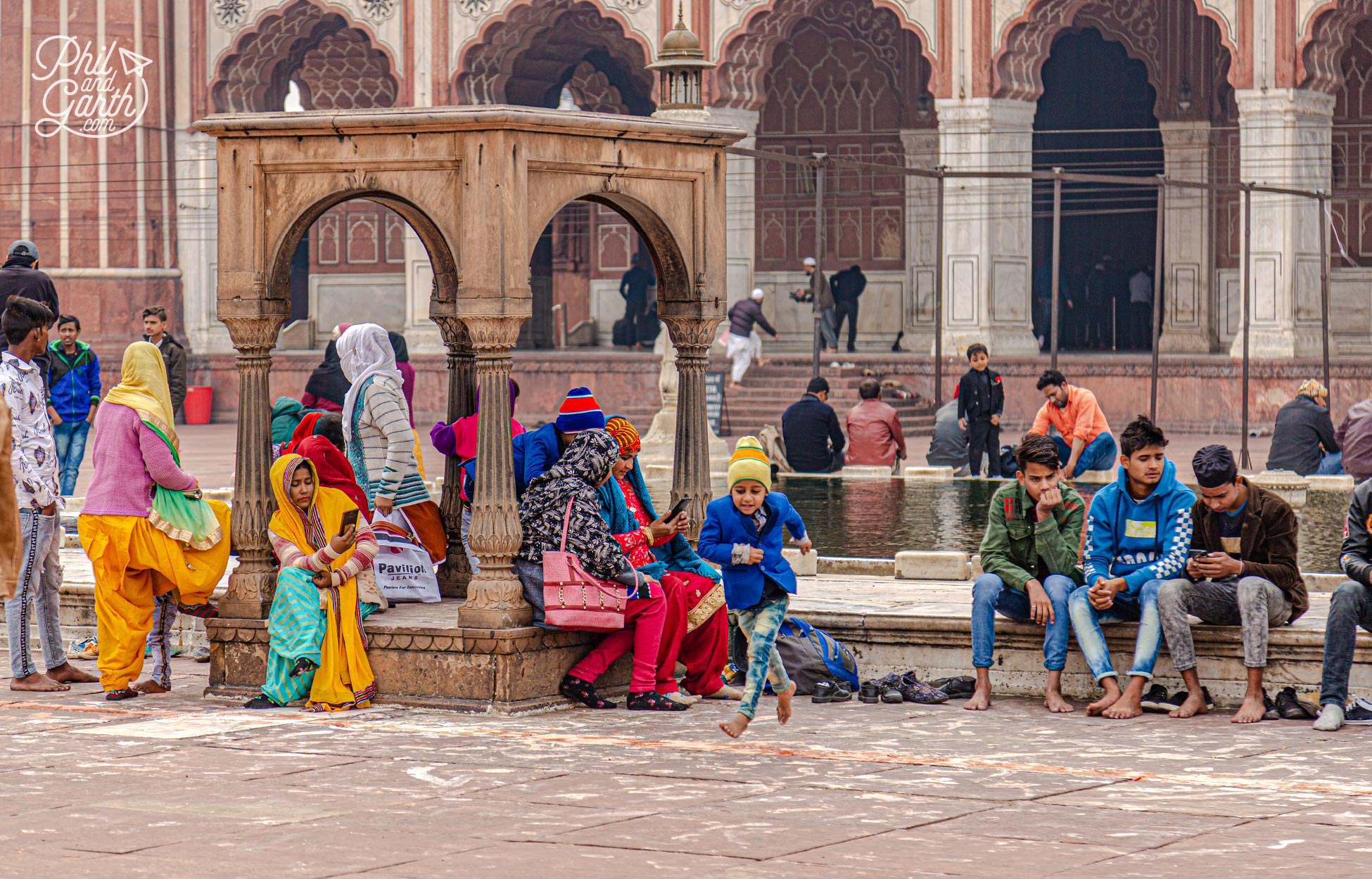
There is a fee of 300 INR to take photographs inside the mosque
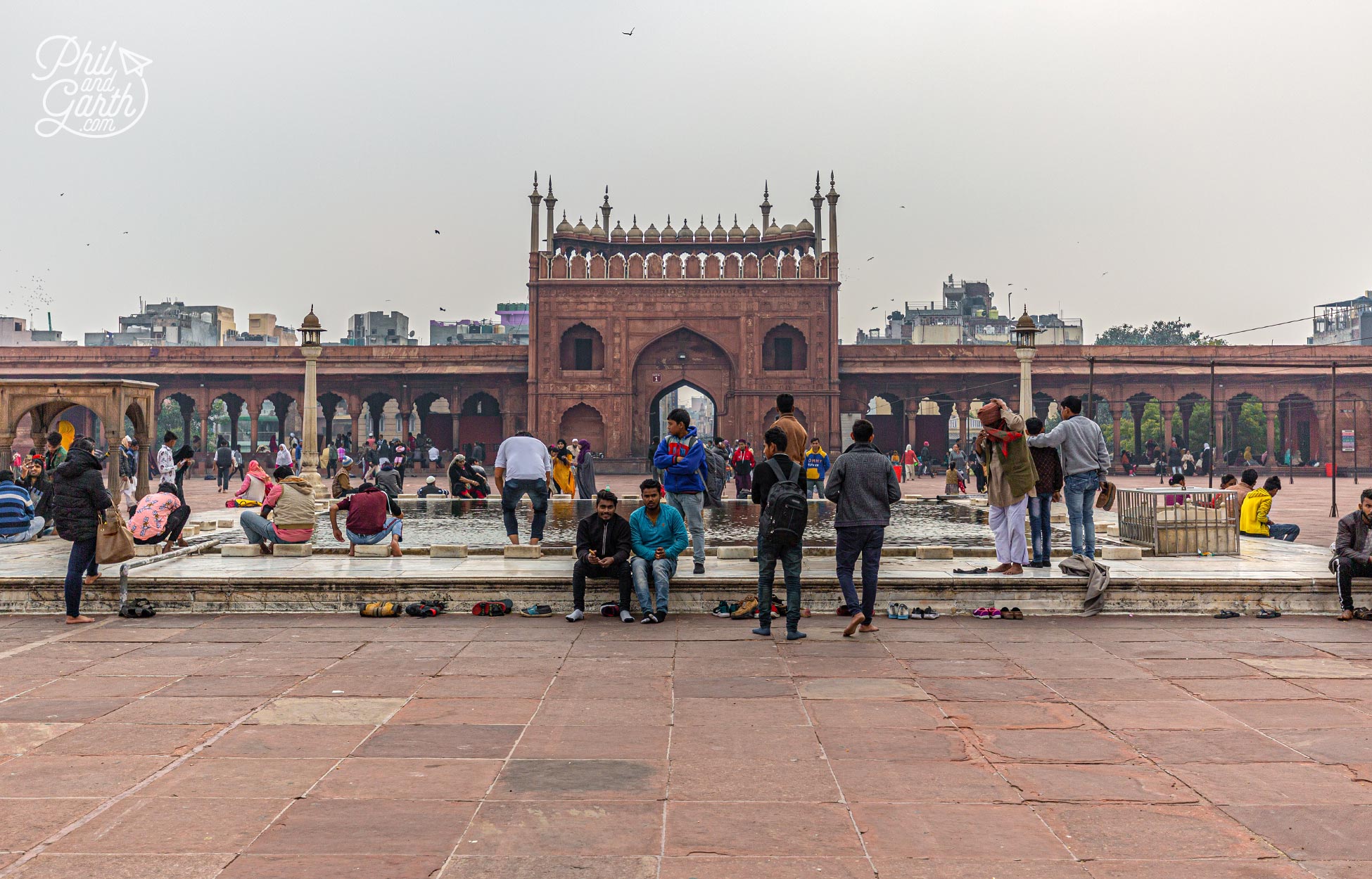
People wash their hands and feet before going to pray
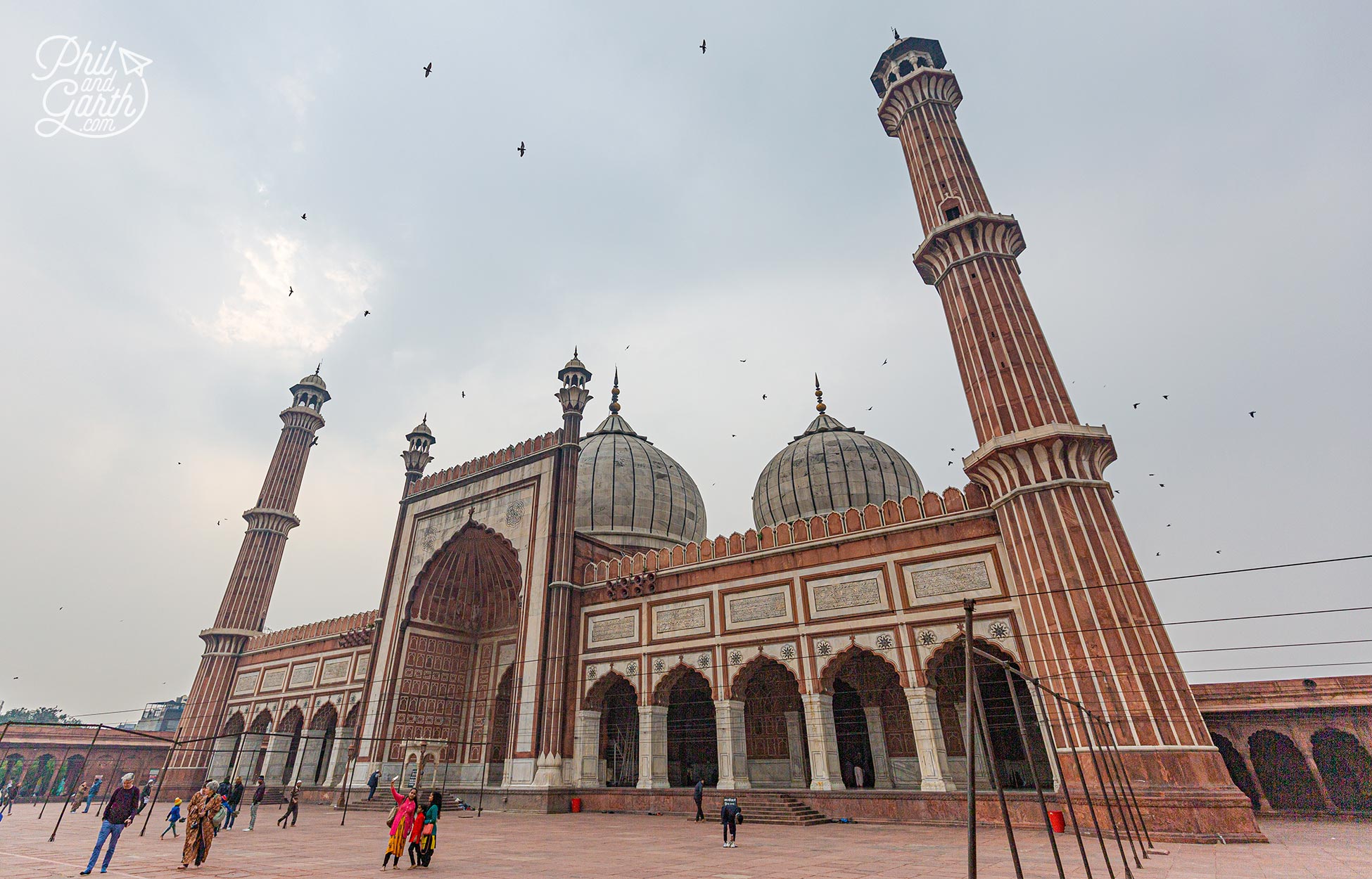
It costs 300 INR to climb the 121 steps to the top of the minaret
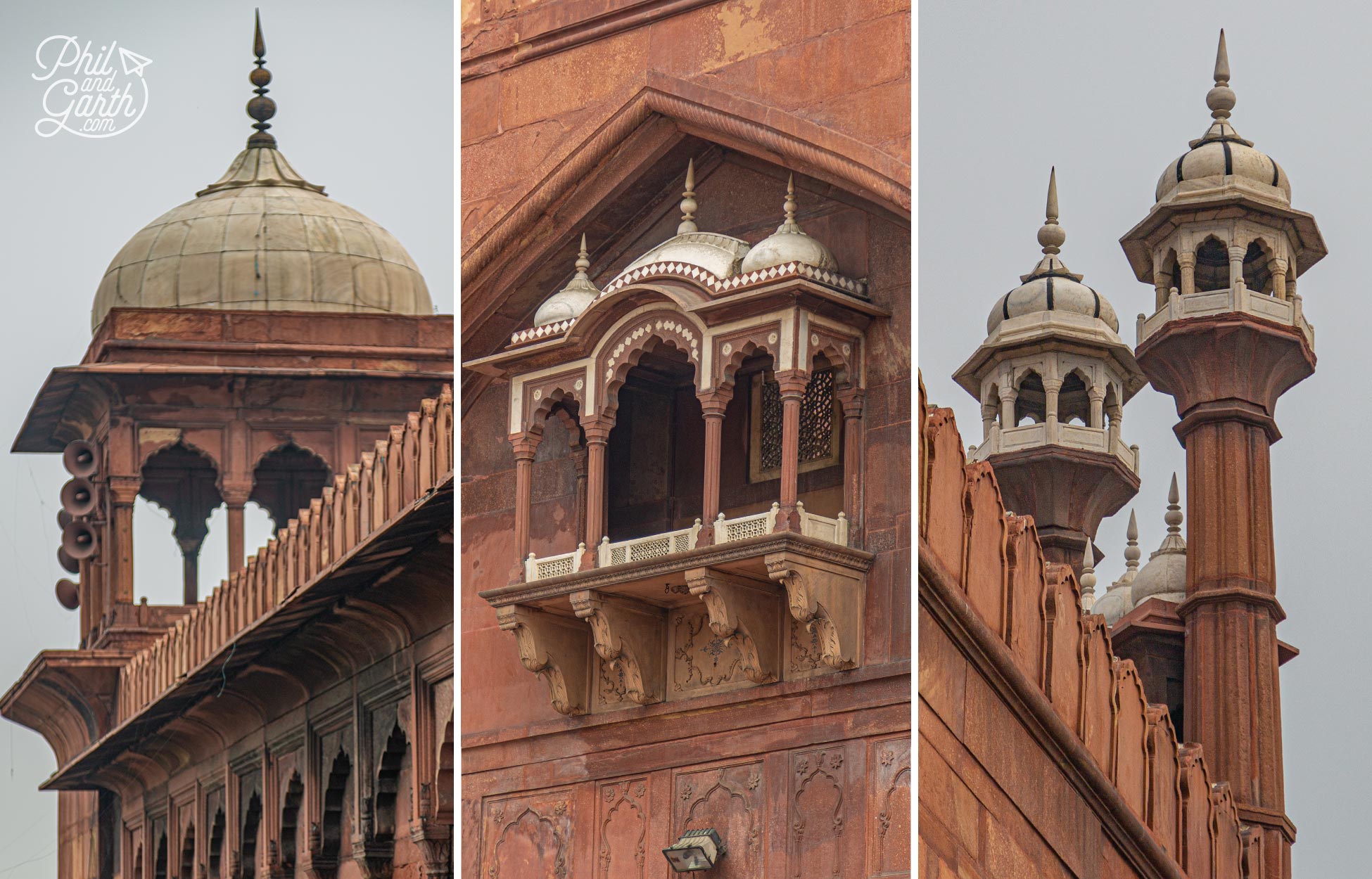
Jama Masjid is famous because it holds a pair of sandals, some hair and a footprint of the Prophet Muhammad
Other Delhi Attractions:
- Red Fort – Near the Jama Masjid Mosque, the Red Fort was the Royal home of many Mughal Emperors.
- Qutab Minar – The world’s tallest brick minaret, also a UNESCO World Heritage Site.
- Lotus Temple – Iconic landmark of Delhi. Place of worship for the Bahai religion, it’s free to enter.
- Lodhi Gardens – 90 acre public park with plus ruins of old tombs.
- India Gate – Memorial dedicated to 70,000 Indian soldiers who died in multiple wars.
- Connaught Place – Located in Central Delhi – modern business hub of Delhi & 5 star hotels.
- Khan Market – High-end shopping bars and restaurants.
- The Safdarjung Tomb – Another tomb-garden dedicated to Prime Minister Safdarjung.
- Haus Khaz Village – This is Delhi’s arty hangout – boutique shops.
- Raj Ghat – Black marble stone memorial to Mahatma Gandhi – this is where he was cremated.
- Imperial High Tea – At the luxurious Imperial Hotel built in 1931.
- Gurudwara Bangla Sahib – Sikh temple with holy water pool for bathing.
- Jantar Mantar – One of 5 giant sundials in India. We visited another one in Jaipur.
- Agrasen ki Baoli – An Indian step well from the 10th century near Connaught Place.
Indian Street Food & How To Avoid Delhi Belly
We LOVE Indian food, it’s always our go to choice at home. So you can imagine we were so excited to be in India and couldn’t wait to try some street food – fast food Indian style. However we read so many horror stories about Delhi Belly! and it’s true you have to be very careful of what you eat and drink. We’re pleased to report we didn’t get Delhi Belly at all and we tried different street food and ate some delicious curries. We reckon it was down to the best piece of advice from an Indian friend who told us to never eat any meat because it might be undercooked or rotten from being transported in poor conditions. So went veggie for our 3 weeks in India which is really easy since most of India is vegetarian. If you don’t fancy eating from the street then go to a growing number of middle class fast food joints selling classic Indian street food. We tried Haldiram’s in the Old Town which is a bit like a hawker food centre in Singapore. So it wasn’t just going veggie how we ate safely in India, there’s a few more things we did. Check out our top tips below for how to avoid Delhi belly.
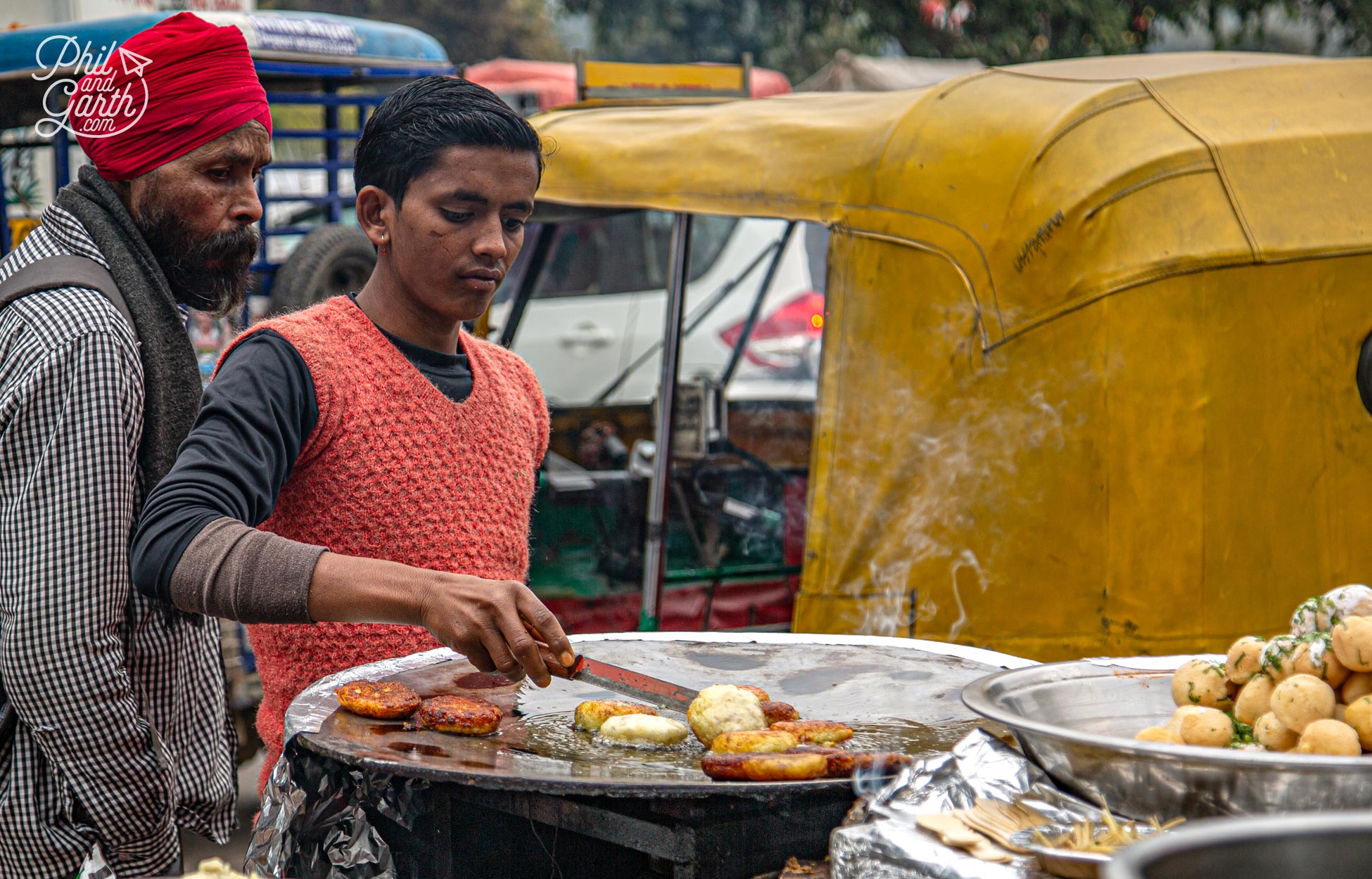
A street food vendor in Old Delhi
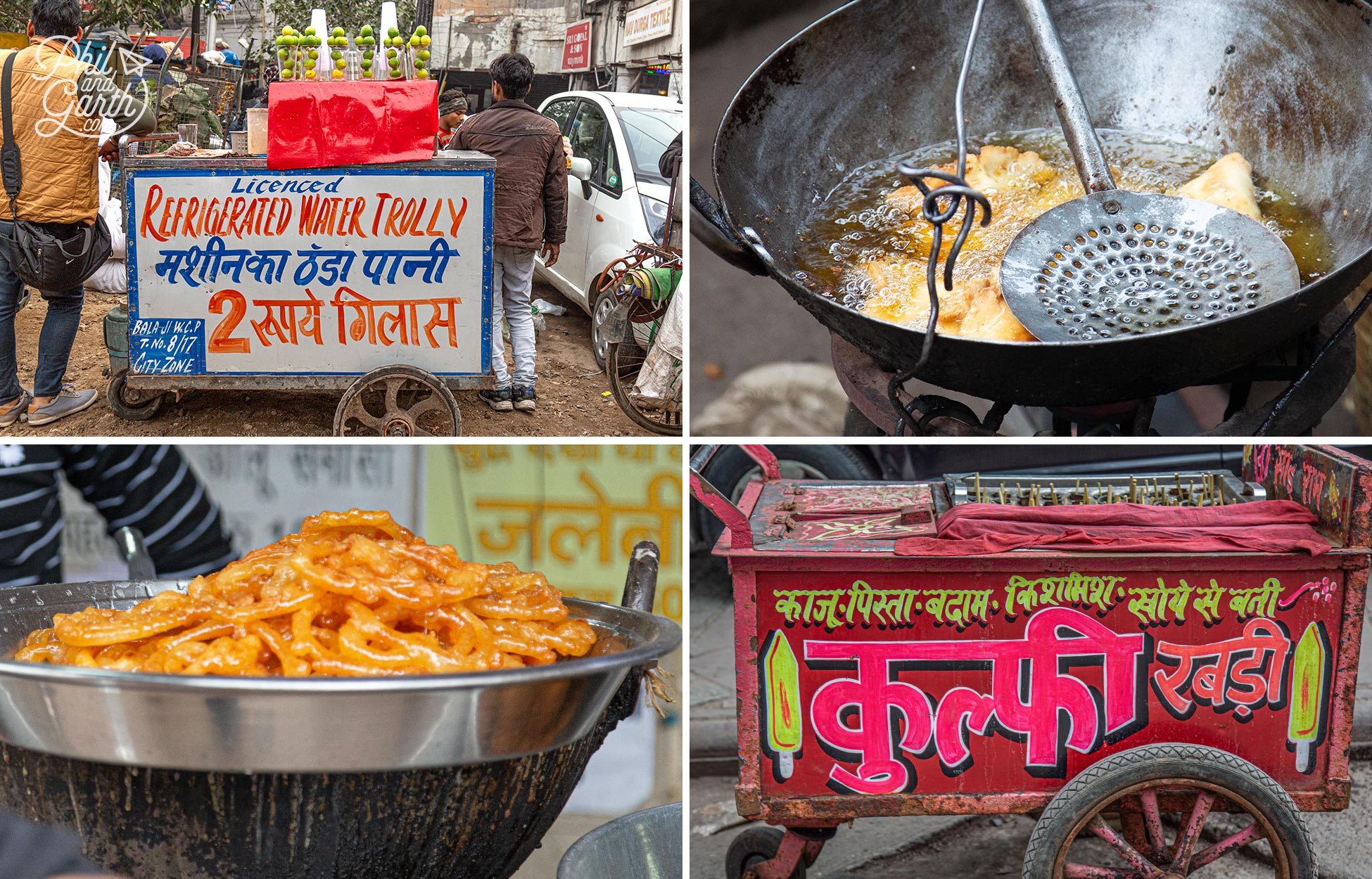
Only eat street food that’s hot and cooked fresh in front of you
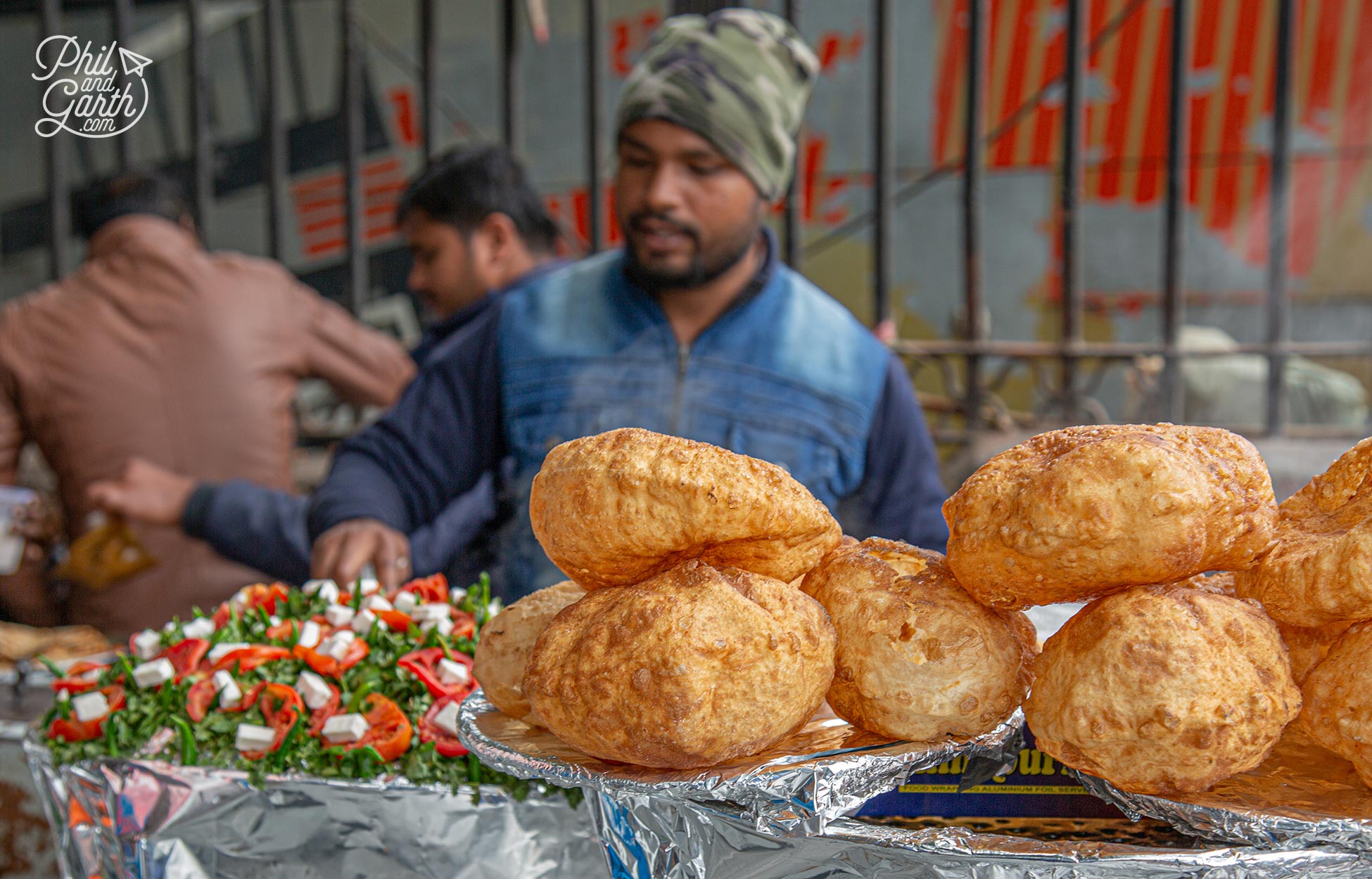
Puffed puri balls ready to be filled
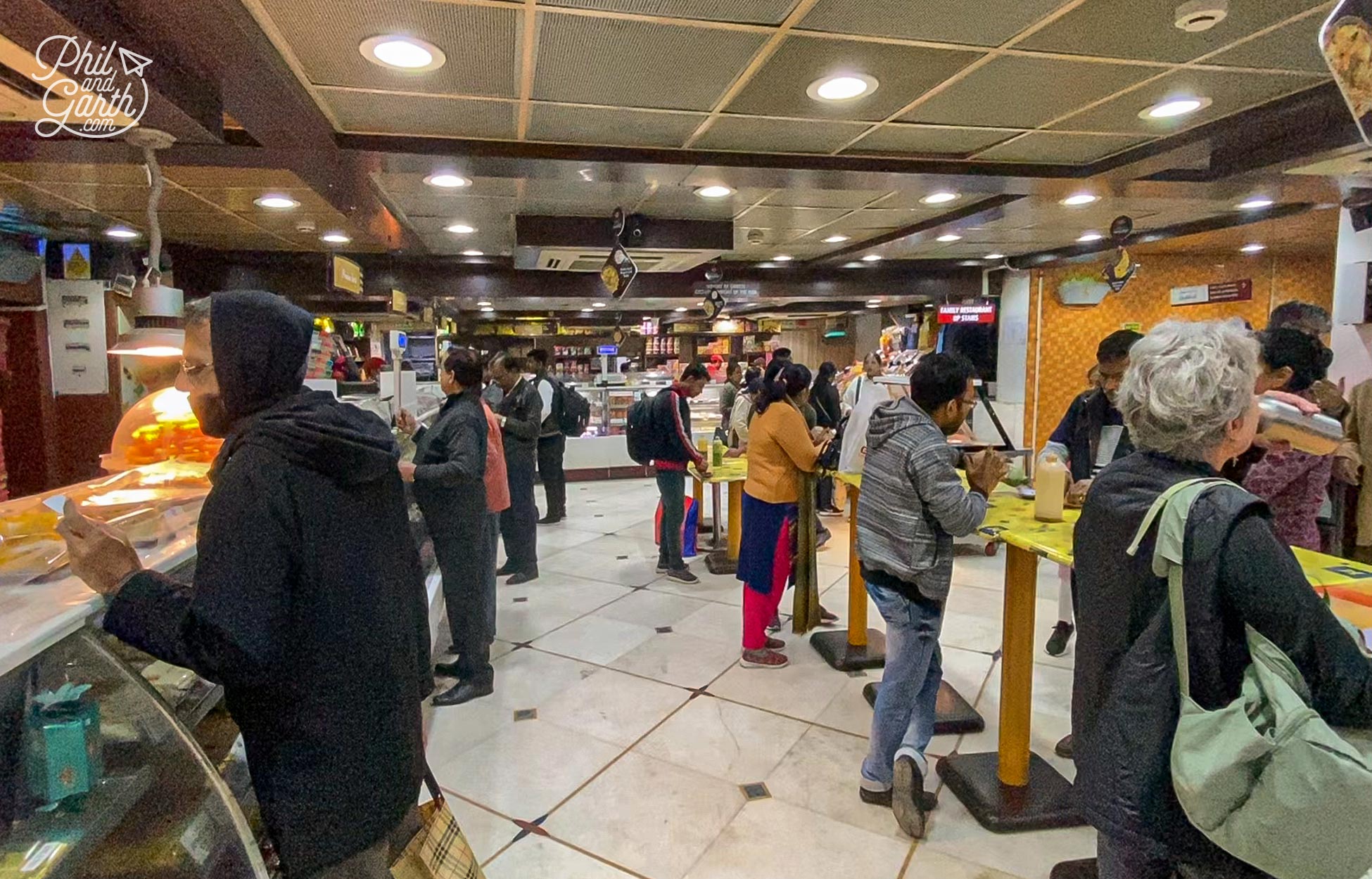
Haldiram’s on Chandni Chowk Road for Indian street food in a hygienic setting.
Tips For How To Avoid Delhi Belly
- Only drink sealed bottled water – it’s really cheap.
- Don’t eat meat! – go veggie every time.
- Only eat street food that’s hot and cooked fresh in front of you.
- Never eat salads or a garnish – they’re probably washed in tap water.
- Don’t have any ice in drinks – stick to bottled beer!
- Don’t eat scoop ice-cream – it might contain tap water or been refrozen.
- Never brush your teeth in tap water.
- Try to avoid dairy products – condensed milk is okay.
- Take your own straw – straws offered to customers are often re-used.
- Some people take probiotics 10 days before they head to India – but not sure if this works?
- Carry diarrhoea tablets with you at all times, just in case Delhi belly happens!
Finally a quote from our travel nurse Lorraine, who always gives us brilliant advice whilst getting our jabs for a big trip. This time we used her phrase like a mantra everywhere we ate, she said:
“If you can’t boil it, peel it or heat it – do not eat it”
Street Food Dishes to try in Delhi
- Samosas – Fried triangle pastries filled with onion, lentils, peas and potato.
- Roti – Same as a chapati – a flat bread usually served with simple potato curry.
- Bhel Puri – Stir fried rice, potatoes, onions, tomatoes and fresh coriander.
- Parathas – Indian flatbread stuffed with curried cheese or vegetable fillings.
- Puri – Deep fried bread balls filled with cheese or potato, chickpeas and spicy masala.
- Aloo Tikki – Spicy fried potato patty.
- Aloo Chaat – Fried cubed potato cooked in masala with onions and chickpeas.
- Masala Dosas – Savoury pancake served with chutney and dips.
- Jalebi – Fried dough swirls soaked in sugar syrup, it’s a sweet dessert.
- Chai Masala – India’s version of tea – flavoured with cardamom, cloves and cinnamon.
Overnight Train to Udaipur
On our last day at 7pm we got our first taste of an Indian railway journey as we boarded our sleeper train at Delhi’s Hazrat Nizamuddin railway station to Udaipur, eek! We were somewhat excited but more nervous, would it be clean? would we sleep? We’ll tell you about this adventure and how to survive India’s sleeper trains in this separate post.
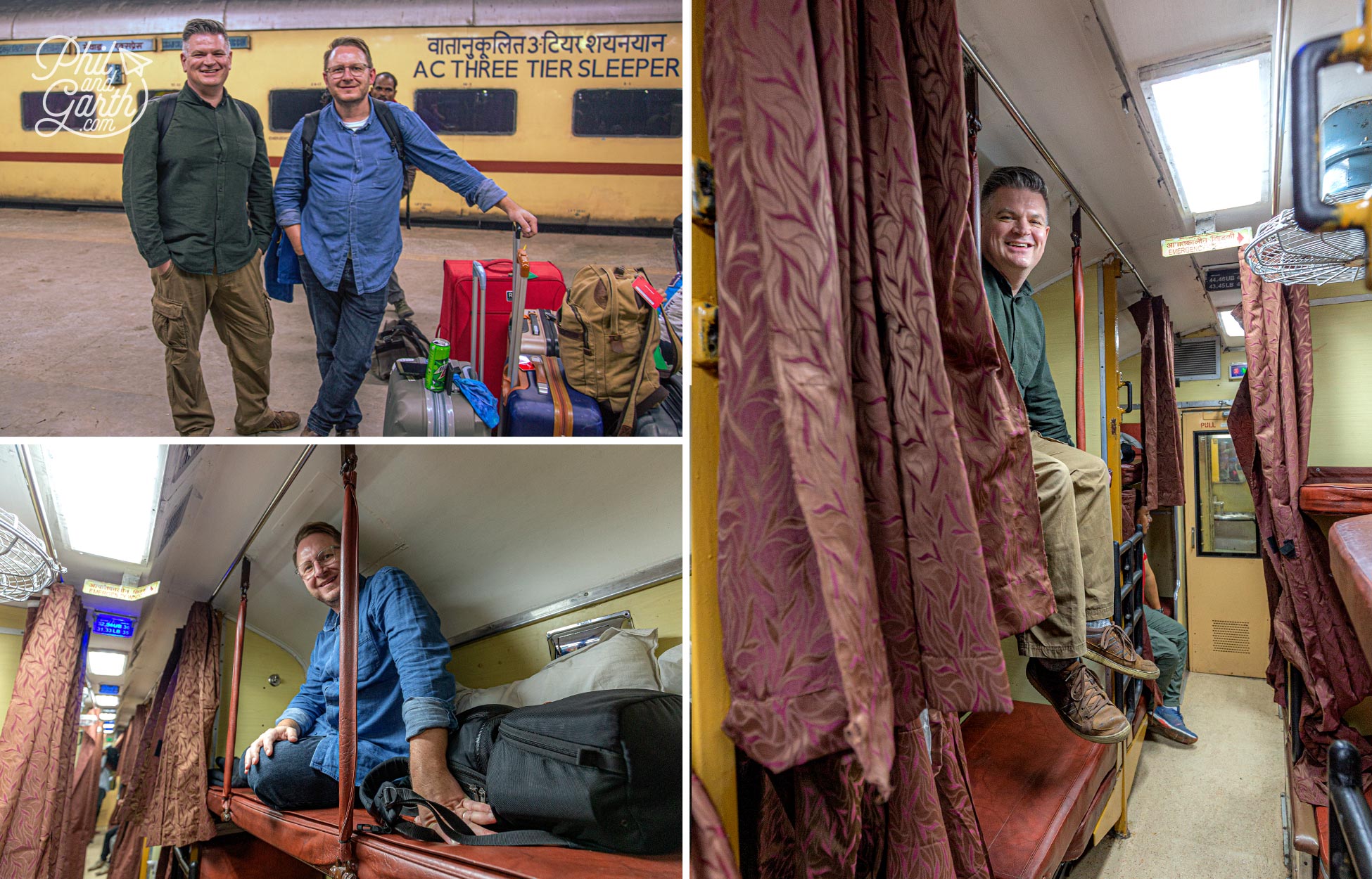
Start of another adventure – catching the train from Delhi to Udaipur
Delhi Practical Information & Useful Advice
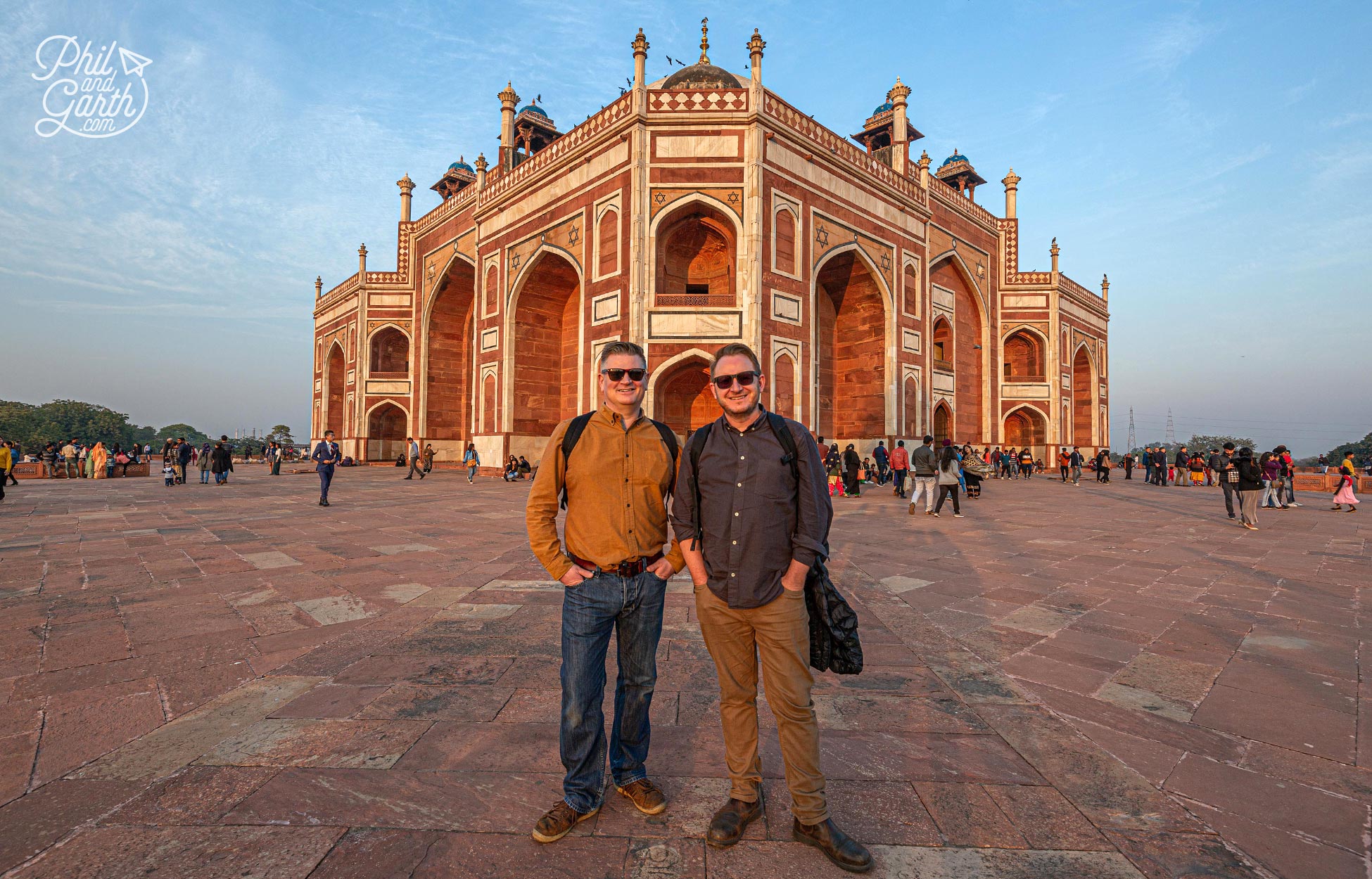
Phil and Garth’s Top 5 Delhi Tips
Phil and Garth’s Top 5 Delhi Travel Tips
- Tip #1: Tie hand sanitiser to the outside of your back pack to remind yourself to use it all the time.
- Tip #2: Don’t plan to visit too much in one day as you will get stuck in the horrendous traffic.
- Tip #3: Run your hotel shower for at least 5 mins to clear out any risk of Legionnaires’ disease.
- Tip #4: Carry toilet paper with you as most toilets only have ‘bum-guns’ to clean your butt.
- Tip #5: You will get hassle from people trying to sell you things, just say “Nai” which is no in Hindi.
Delhi FAQ
- What is the airport code for Delhi? DEL – Indira Gandhi International Airport.
- What time zone is Delhi? GMT +5.30 hours. India Standard Time.
- What currency is used in Delhi? Indian Rupee (Symbol: ₹)
- What language is spoken in Delhi? Hindi, Punjabi & Urdu.
- What is the population of Delhi? 30,291,000.
- What number should I use in an emergency? Call 112. Additional number – 100 for police.
- What plug type is used in Delhi? Plug Types C, D & M. The 3 round pin type is the most common. Voltage is 230V / 50Hz.
- When is the best time to visit Delhi? November to March. Delhi gets heavy winter fog, it’s usually gone by the end of January.
- When is the worst time to visit Delhi? June to September is monsoon season and very hot.
- What is Delhi famous for? Capital of India, Ancient landmarks and Markets.
- What is the history of Delhi? The first king of Delhi was Raja Dhilu in 50 BC. The term Delhi is said to have originated from his name.
- What are the 5 must see sights in Delhi? Humayun’s Tomb, Jama Masjid Mosque, Red Fort, Chandi Chowk Market and the Lotus Temple.
- What is the local dish in Delhi? Chole Bhature is Delhi’s signature dish. Fried bread served with a spicy chickpea curry.
- What is the best way to get around Delhi? The underground Metro is the easiest way to get around. It’s easy and clean.
- What’s a fun fact about Delhi? Delhi’s iconic Lotus Temple is the only structure in Asia dedicated to the Bahai Faith.
- What movies have been filmed in Delhi? Eat Pray Love (2010) Jobs (2013) and Million Dollar Arm (2013) were filmed in Delhi.
- Where is the best photo spot in Delhi? Humayan’s Tomb.
- Where is a hidden gem in Delhi? Agrasen ki Baoli.
- What is the best souvenir to buy in Delhi? An Indian spice box.
How We Did It
- We visited Delhi at the end of January, temperatures were nice during the day averaging about 20ºC (62ºF) however the evenings were very cold. Most hotels don’t have heating so we asked for extra blankets.
- We stayed for 2 nights at the Evoke Lifestyle Hotel in New Delhi – a budget 3 star hotel with wafer thin walls! Hotels are nowhere near as clean as western standards, so we took wet-wipes with us for cleaning surfaces. However the food was very good, the veggie matar paneer and tarka dal were delicious.
- We applied for our Indian visas 6 months in advance. The website is very clunky to use and we were really surprised at how much extra personal information they wanted compared to applying for visas to other countries.
- We paid for a small group touring holiday with Explore, their ‘North India Explorer’ tour.

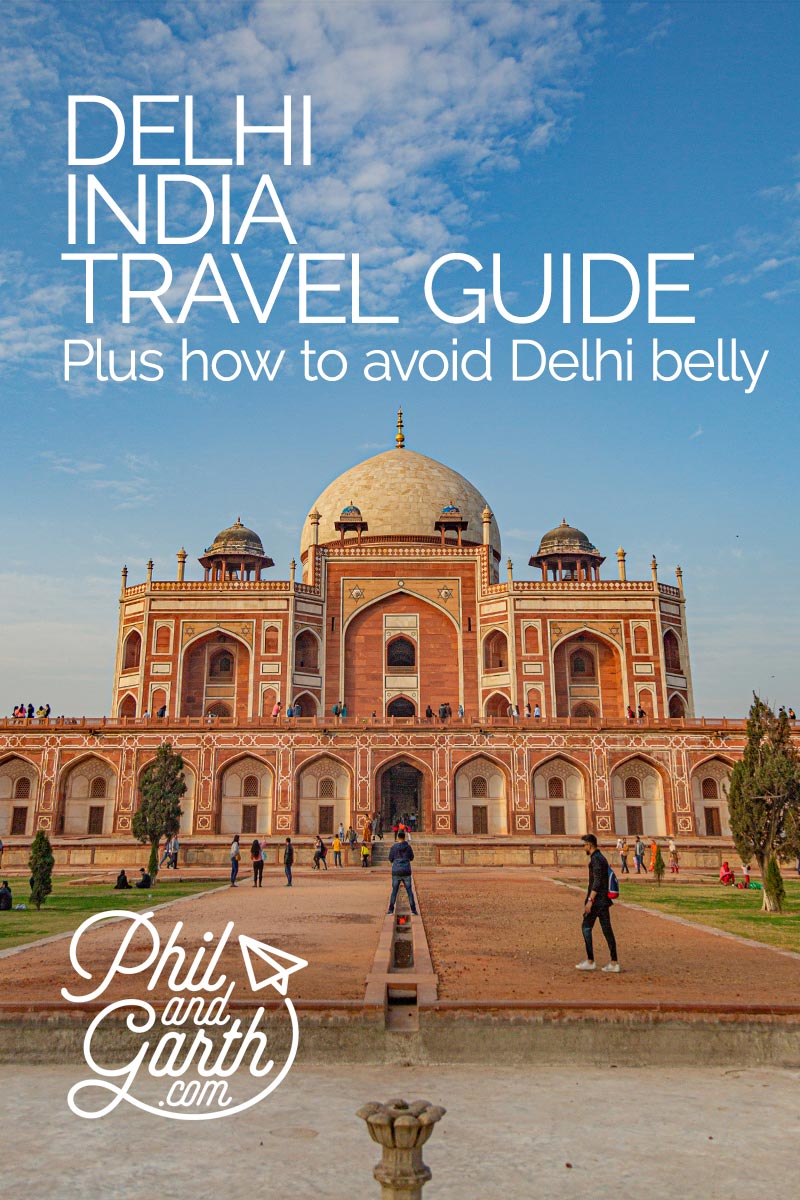
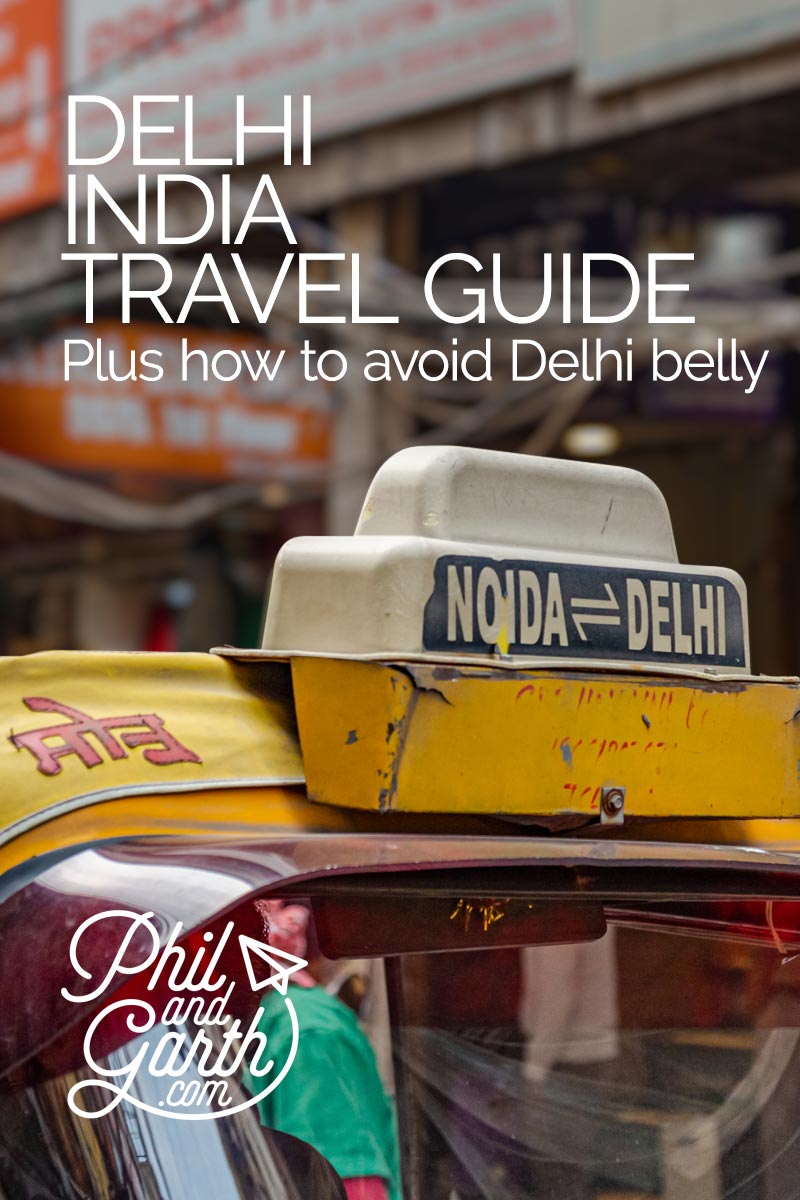
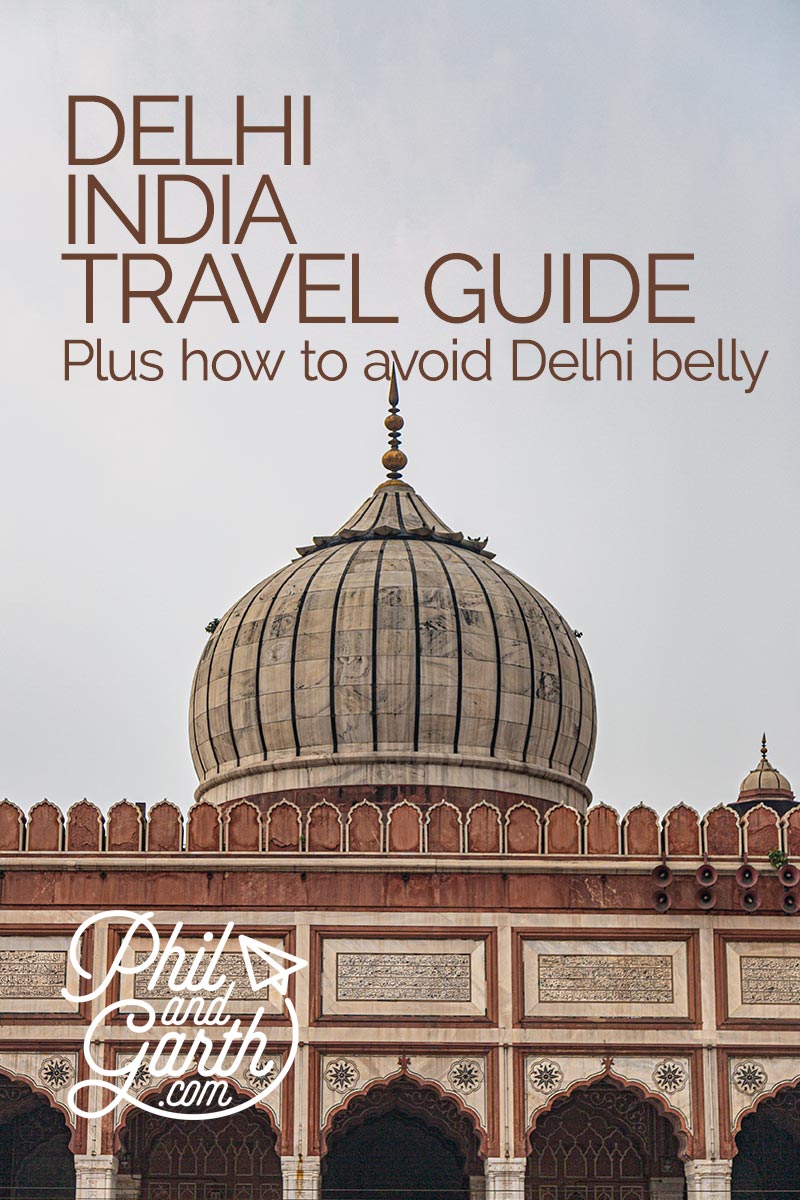
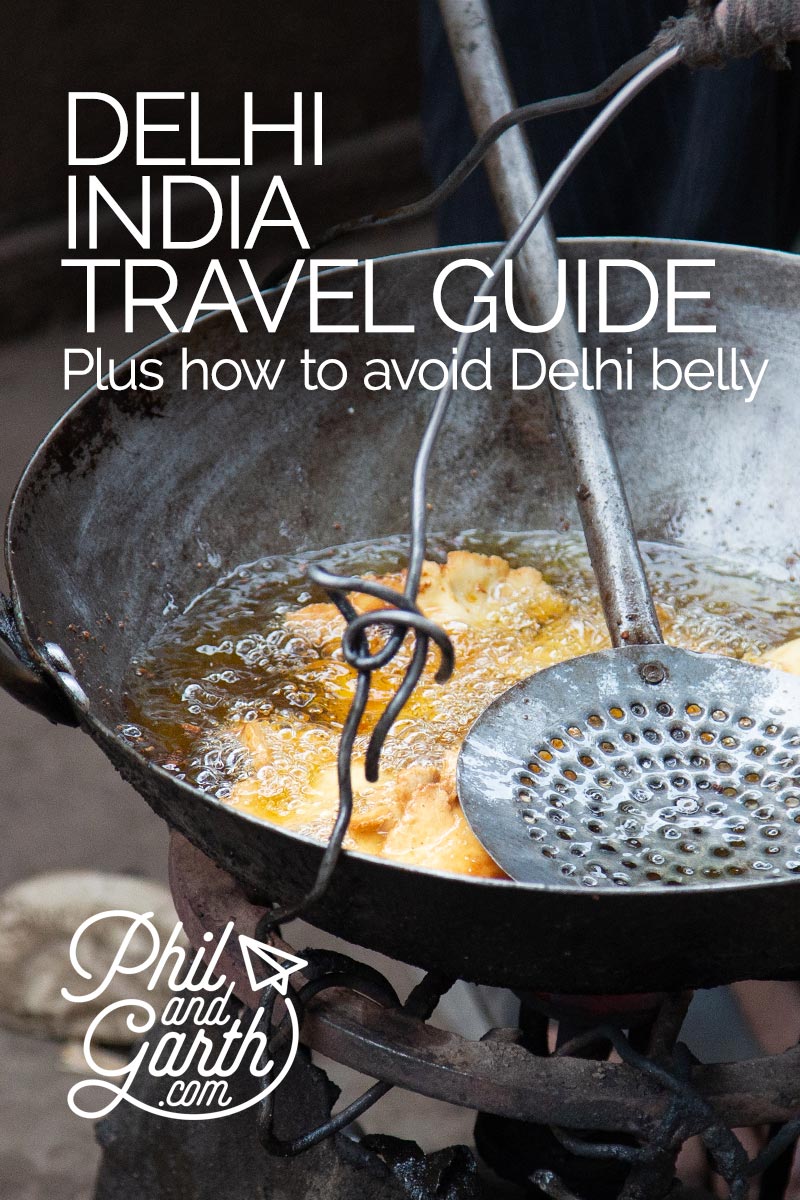

3 comments
Nice and well narrative post
Such beautiful photos and a great post! I will go veggie for my visit! Thank you!
Delhi is a great city to spend time in. Sounds like you enjoyed it too. Karim’s original restaurant, near the Jama Masjid, serves a delicious slow-cooked lamb dish, called Raan, which is well worth trying when you are in India’s capital.